From Watchtowers to Vistas: A Guide to Visiting The Great Wall of China
As one of the ‘new’ seven wonders of the world, you likely already know about the Great Wall of China. Often on travel bucket lists, The Great Wall is a bastion of historical integrity and offers some of the best views in China.
If you are considering visiting this ancient marvel, we’ve got a few tips to help you plan your trip. In this article, we will give you a full rundown of what to expect when you visit the Great Wall of China, including background about the wall, how you can get there and the best sections to visit for your trip.
We will also give some recommendations of where to stay near the Great Wall and provide some top tips to make your excursion a real treat.

History and Background of The Great Wall
The Great Wall of China stands as a monumental testament to China’s rich history and enduring heritage. Its origins trace back over two millennia, with construction dating as far back as the 7th century BC. It is such a significant monument in human history that it is listed as a UNESCO World Heritage site .
Initially built by various states and dynasties as separate defensive fortifications, it was during the Qin Dynasty (221-206 BC) that the walls were largely connected, forming the foundation of the iconic structure we recognise today. With its strategic significance, the wall witnessed expansions, renovations, and enhancements across many centuries.
The Great Wall of China’s length spans approximately 21,196 km and crosses 15 of China’s provinces. Unfortunately, the claim that it can be seen from space is false, but down on Earth, nothing is stopping you from seeing it with your own eyes.
How to Get to The Great Wall
Since the wall stretches out over such a long distance, there are many different ways to access the site. We recommend visiting from the capital Beijing, as some of the most accessible sections, like Badaling and Mutianyu, are just an hour and a half away.
From Beijing, you can get a train at Huangtudian Railway Station that will get you to the Great Wall in just 1.5 hours. That said, traversing China’s public transport can be quite tricky, as there is minimal English signage. For a more convenient trip, consider hiring an English-speaking driver who will also be able to guide you through the top sites on the Great Wall.
The 5 Best Sections of the Great Wall to Visit
The biggest consideration when visiting the Great Wall of China is which section you want to visit. Some sections are much more popular and have large tourist groups at all times of the year. Alternatively, there are some wilder sections of the wall which can be a real delight for their stunning natural views, but can make for a more demanding hike.
You can easily do multiple sections if you are staying for an extended period, but you will want to dedicate at least half a day to each. Below, we give you some details about the best sections of the Great Wall for your visit and what to expect when you arrive.
If you want to see the Great Wall of China in all its glory, the best section to visit is Badaling. Situated in the beautiful Yan Mountains, Badaling is easily reachable from Beijing in just under 2 hours. This part of the wall is one of the most popular among local and foreign tourists and is one of the best destinations for a guided day trip .
The section includes 7km of well-restored fortifications, so don’t be afraid to venture out and explore to beat the bustling groups of tourists. Be sure to check out the watchtowers dotted along the wall, where you can enjoy some of the best panoramic views of the surrounding mountainous landscape.
Since Badaling is very popular, you can find many shops and restaurants here that will help bulk out your visit. You can also take time to explore the Great Wall Museum. The building is designed to imitate the structure of the walls and includes 9 exhibition halls which detail the fascinating history of China’s greatest monument.
Juyongguan is one of the closest sections of the Great Wall to Beijing, located just 50 km northwest of the city centre. It is also one of the most accessible, as it is very close to the highway and there is a car park just below the Pass Towers.
Juyongguan played a significant role in safeguarding Beijing and the northern territories from invading forces in ancient times. Its strategic position in the mountain pass provided a great natural defence and its position also established it as a very important trade route.
Known as the “Valley Pass,” Juyongguan showcases both natural beauty and historical significance. The lush surroundings complement its well-preserved structures, creating a serene yet impactful visit. At the very top of the pass, visitors can find the stunning Cloud Platform Pavillion after ascending a steep staircase.
Mutianyu enjoys fewer crowds than sections like Badaling, making it a great choice for travellers seeking a serene experience of the Great Wall. Taking a guided tour of Mutianyu is a great choice for those who want a varied visit, with great views, ancient architecture and even exciting activities.
Mutianyu will appeal to both history buffs and nature enthusiasts. It is renowned for its picturesque landscapes, as from atop the wall you can look out onto the verdant hills of northern China. The cable car provides equally beautiful mountain vistas and a convenient means of accessing the Great Wall.
The fortifications at Mutianyu are very well restored, but there are also some original sections of the wall left which provide insight into the ancient origins of the Great Wall. This section dates as far back as the Qi Dynasty from 550 CE. During the much later Ming Dynasty, much of the original wall was reconstructed and further fortified.
Once you’ve explored Mutianyu, you can either get the cable car back down the wall or you can take the thrilling toboggan ride. On the toboggan, you can enjoy amazing views of the natural scenery while you glide along the rails at high speeds. It’s a uniquely fun experience and a great way to round off your visit.
For an authentic experience of the wall’s original state, Simitai is the top choice. This section is much more remote, being 120 km from Beijing. Simitai is less visited than other sections and is known for its rugged allure, unrestored features and wild beauty.
Hikers will have a great time at Simitai since it is one of the better sections for walking tours . The routes can be quite challenging, as the majority of this section is unrestored and some parts have heavily eroded. It’s a more challenging hike, but you will be rewarded for your efforts with unspoiled beauty and a glimpse into the ancient construction.
This section of the Great Wall of China is more suited for experienced outdoor travellers who want to test themselves. Even so, you may be compelled to visit Simitai for the unique opportunity to enjoy a nighttime tour. Simitai is known for offering starlit tours of the wall and its remote location provides minimal light pollution for a truly unforgettable experience.
Another section of the wall that is more suited to travellers seeking rugged beauty and wilderness walks is Jiankou. A haven for adventure seekers, Jiankou boasts steep and challenging terrains. Its wild and unrestored state provides an authentic, rustic experience that’s unmatched by other sections.
Situated in Huairou, 100km north of Beijing, this is perhaps one of the most unvisited sections. You won’t find a ticket office here, nor are there cable cars or gift shops. You will simply see the stretch of wall as it rises and falls along the graceful peaks. It is an idyllic sight that is perfect for those who want to avoid tourist crowds.
The Jiankou section has been largely untouched since the original Ming Dynasty fortifications. Due to its rough terrain, the construction of Jiankou was quite difficult, which resulted in its distinctive, raw appearance. It’s one of the best sections of the Great Wall of China to visit if you are more intrigued by the original state of the wall rather than the appeal of modern restorations.
How to Get Tickets for the Great Wall
You can purchase your tickets when you arrive at the Great Wall. Prices can vary depending on what time of year you visit. During the summer, entrance fees range from 40-65 Yuan (£4.35-£6.52), but from November to March prices drop to 35-55 Yuan (£3.80-£6.00). If you book a private Great Wall of China tour , the cost of entry is normally included in the price.
If you are planning to take a cable car up to the Great Wall, this will cost an additional 120 Yuan (£13.00) for a round trip. Likewise, if you want to try the daring descent of the Mutianyu toboggan ride, this will cost an extra 100 Yuan (£10.90).
Where to Stay Near the Great Wall
You can find loads of places to stay in Beijing , which would be perfect for your Great Wall of China holiday. However, if you want to stay on the Wall itself or in the nearby area, we’ve got some great suggestions.
If you want to spend as much time as possible at the Great Wall of China, consider staying a night or two at The Great Wall Courtyard Hostel . The simple rooms are equipped with a private bathroom and wifi, making this hostel a great place for an overnight stay while visiting the wall.
For travellers looking for a lavish getaway, Commune by the Great Wall in a stunning retreat near Badaling. The hotel features 176 rooms that are spread across multiple villas, with every room sporting a breathtaking mountain view. You will also find a wonderful array of activities on offer here from stargazing to tai chi, making it the perfect place to unwind after a long day on the Great Wall.
Tips for Visiting The Great Wall
Traversing the Great Wall is one of the most breathtaking travel experiences you can have. Though it may seem intimidating at first, we’ve got some helpful tips to make your visit stress-free.
For starters, the best thing you can do for your visit is to wear appropriate clothing. A Great Wall trip will include a lot of walking and steep inclines if you take the steps up to the wall. Be sure you wear sturdy hiking boots or trainers and pack a light jacket, as there can be cold winds atop the wall.
Another great tip is to be meticulous about when you go to the Great Wall. We previously mentioned that tickets are cheaper outside of the summer high season, but there are also fewer crowds filling up the ancient structures. You will also find the weather in spring and autumn more pleasant for your visit as the days will be much milder, making the strenuous hikes much more bearable.
If you are planning to visit the wild sections of the wall such as Jiankou or Simitai, be sure you travel with a group unless you are a very experienced hiker. The paths can be uneven, difficult to traverse and pose some risks.
There are many campsites dotted along the Great Wall which are perfect for travellers who want to enjoy the great outdoors. More remote sections of the wall can be camped on, but it is worth noting that wild camping is prohibited at Badaling and Mutianyu.
From the awe-inspiring watchtowers that have witnessed centuries of history, to the unparalleled vistas that stretch across this monumental structure, a visit to the Great Wall is an experience that resonates on both a historical and personal level.
As you plan your trip, consider the diverse array of sections available for exploration. Whether you opt for the more accessible Badaling and Mutianyu sections, the rugged authenticity of Jiankou and Simatai, or the serene beauty of Juyongguan, each section offers a unique perspective on this remarkable monument.
If you’ve enjoyed this Great Wall guide, you’ll love our top 10 things to do in Xian post. Or if you’re planning a China trip, check out our China travel guide for some great trip inspiration.
How much does it cost to visit the Great Wall of China?
Admission fees will vary depending on which section you choose to visit. General admission for Mutianyu is 40 Yuan (£4.35) for adults, and 20 Yuan (£2.20) for seniors and children under 1.4 metres tall. Children shorter than 1.2 metres can enter for free.
What is the most visited part of the Great Wall of China?
Badaling is the most visited section of the Great Wall. It is one of the easiest parts of the ancient structure to visit and is the starting point of many guided tours. This section is much more restored than others which makes it very easy to visit.
Some of the links on this page are affiliate links, which means we can earn a small commission when our visitors click on them. This helps us to keep our content free and accessible for everyone, but you’ll never be charged for engaging with them.
About the Author

I am an experienced writer with a diverse background, having lived in 7 countries by age 16. I have specialised in various topics throughout my career, such as archaeology, sports and travel writing. Having grown up abroad I feel a special connection with the countries I once called home, in particular China, Singapore and Thailand. With my archaeological background, I also have a plethora of historical knowledge about Italy, Greece and Egypt. My favourite thing to do while travelling is visiting museums and historic landmarks and learning more about the local culture. As a foodie, I also make a point of sampling as much local cuisine as possible whenever I visit a new country. My favourite place I’ve visited so far has to be New Zealand, but I also loved Hong Kong and Copenhagen.
DESTINATIONS

Central America
North America
South America
© 2009-2024 – BACKPACKERBOY

WEBSITE DESIGN BY SEO TRAVEL

Tiananmen Square
Forbidden City
Best Restaurants
Foods to Try
Nightlife in Beijing
Best Time to Visit
Weather & Climate
Beijing Airport Guide
Top Neighborhoods
Getting Around
Three-Day Itinerary
Things to Do
Shopping Streets
Great Wall of China
A Complete Guide to Visiting the Great Wall of China
bjdlzx / Getty Images
- How to Visit
Huanghuacheng
Jinshanling, tour or solo, how long to spend, where to stay.
The Great Wall of China stretches 13,000 miles over mountains, forests, reservoirs, and desert. It took a millennium to build, involved multiple dynasties, and pissed off a lot of Huns. Inextricably tied to the history of the country, to visit China without seeing it would cause you to be remiss not only with your friends and family at your homecoming, but somehow within yourself as well. To stand on its ramparts gives one simultaneously a sense of experiencing something collectively epic and individually infinitesimal.
Before you visit, decide if you want to go to an unrestored section, wild section or both. (“Wild” is a popular way to refer to the unrestored sections of the wall.) Consider physical ability and whom you’re traveling with (old people, kids, your sister who hates walking) when choosing a section.
This will be a workout. It’s not strolling on an elevated side walk. The Great Wall is stone waves steep and undulating. Grab your hiking boots and prepare for the walk of a lifetime.
How to Visit the Great Wall
Most visitors go to the Great Wall as part of a half or full day trip from Beijing. Visitors can choose from over 12 well-known sections and access them through a group tour, private driver, private tour, public transportation (sometimes combined with taxis), or by driving their own car. While the travel time from Beijing varies depending on section and traffic, it can take anywhere from one to three hours to get to there.
Worthwhile sections to visit in other provinces are the famous packed-earth Jiayuguan section in Jiayuguan, Gansu Province. It's a mere 4 miles (6 kilometers) from the city and easily accessible by public transport or a short taxi ride. Also, Ningxia Province’s Sanguankou section with its three passes is about 25 miles (40 kilometers) from the province's capital city of Yinchuan. It can be reached by hiring a private car.
If you want to hire a tour operator for a section near Beijing, Beijing Wonder Tour has affordable rates and English-speaking guides. Beijing Hiker’s offers hiking tours to the wild wall. If you want to hire a private car with an English-speaking driver but explore the wall on your own, you can choose from a number of options here . If you want to hire your own car, Hertz rents cars from the Beijing airport.
Best Parts of the Great Wall
The Great Wall spans nine provinces. The sections most commonly recommended are all close to Beijing. However, for less touristy and wilder parts of the wall, you can head to Gansu, Ningxia, or several other provinces less frequented by visitors. All of the ones listed below can be accessed from Beijing.
Popular among foreign tourists and easily accessible from Beijing, Mutianyu offers a well-restored wall with 23 watchtowers, replete with photo ops and views of the surrounding mountains and forests. You can hike, take a chair lift or cable car to the top, and toboggan down. It takes about two hours to walk the 1.4 miles of this section. If you go beyond tower 23, the wall is not restored, has no guardrails, and tourists are responsible for their own safety.
To get there hire a private driver or take the subway to Dongzhimen station. Walk upstairs to the North Bound Platform. Take the Express Bus 916 towards Huairou. After about an hour, get off at the Beidajie stop. Take bus H23 to Mutainyu or share a car with other tourists going there. Travel time is two to two and a half hours.
Simatai's main draw is night tours. Though Badaling is also open at night, Simatai has more ambient lighting and fewer crowds. You can take the cable car up and walk this 3-mile section for about one and half to two hours. Be aware that its grade increases rapidly (from 968 to 3,235 feet) and is super steep. The Simatai wall cuts through the Simatai Reservoir, and those who want to can zipline over it. For the day hikers, Heavenly Ladder and Sky Bridge are two extremely narrow and high parts of the wall with incredible views of mountain ridges.
To get there hire a private driver, or hop on the Airport Express subway line to Dongzhimen station. Take Bus 980 from Dongzhimen Long Distance Bus Station to Miyun Town and then take a taxi.
This section's surrounding countryside boasts a sea of yellow flowers in spring and summer. Other distinguishing features of Huanghuacheng include: boat rides on Haoming Lake, and fewer crowds than Mutianyu and Badaling. It can also be combined with Mutianyu for a day trip, as the two sections are only a 40-minute drive apart.
To get there hire a private car, or take the 916 bus or 916 express bus to Dongzhimen to Huairou Bus Station. Hop on the H21 bus to the Small West Lake (Lakeside Great Wall) Station, and walk north to the scenic area. By public transport, it will take at least two hours from central Beijing.
For those who can’t decide if they want to see a restored or wild section of wall, Jinshanling offers a beautiful mixture of both. Ideal for hikers, this section stretches 6.5 miles, runs along the Jinshanling Mountains, contains 67 watchtowers, five mountain passes, and very few tourists. If you hike in this section by itself, plan for two to five hours. You can also hike from this section to other sections, such as Simatai or Gubeikou.
To get there, hire a private driver or take the subway to Wangjing West Station. Hop on the bus to Luanping, and get off at Jinshanling Service Area. This bus will take about two hours to get to Jinshanling Service Area. Once you alight, you can take a free shuttle to the wall.
If you want to see the section of the wall closest to Beijing and can handle huge crowds, this will be your option. Though super touristy, Badaling has amazingly restored wide walkways and guardrails for its steeper parts. Like the Mutianyu section, it offers a cable car and toboggan rides for those who want to save their energy and feet. Plan for one and a half hours to visit this section of the Wall and walk the 2.3 miles of its restored path. Check out the 19 watchtowers along the way and be prepared for tons of hawkers.
To get there hire a private driver or take the subway to Jishuitan station. Go out exit B2 and hop on the 877 bus, a direct bus with a travel time of about one and a half hours to get there.
Tips for Visiting the Great Wall
Use these tips to make the most of your visit.
You do not need to book a tour to the Great Wall, though it can eliminate the stress of trip planning and language barriers. If you are traveling solo or with one or two other adults, hiring a driver or using public transport will most likely be your best options.
If you are traveling in a large group or with children or with elderly family members, a tour or private driver will be your best options. Some tours will take you to a government sponsored tea house or jade museum during the trip. Know what you’re buying if you go the tour route, and look for tours that state they do not do commissioned stops.
Weather-wise, spring and fall are the best times to see the Great Wall. Spring will provide beautiful verdant greens (and yellow blossoms around Huanghuacheng). In the fall, the rolling forested hills on either side of the wall will be dappled with red, orange, and yellow leaves. However, the best time to go to avoid crowds is winter.
Wear layers. It gets windy and most of the sections are exposed. Even the watchtowers have giant open window frames. If you go in the summer, take a hat and sunscreen.
Spend at least three to four hours on the wall, this is one of the Seven Wonders of the World and a UNESCO World Heritage site after all. Take some time to enjoy it. Sections can be steep (even if restored) and ascents slow. Stroll through the blockhouses and watch towers, sip water as you admire the surrounding hills, and zip down to the base in a toboggan (if you go to Badaling or Mutianyu).
If you want to experience the Great Wall early without leaving Beijing in the wee morning hours, consider staying at a hotel by the section you want to see. For Muitanyu, The Brickyard offers comfortable rooms, a restaurant, and a spa. Alternatively, if you want to go to the wall during the day, but also see it lit up at night, go to Simatai. Stay at Gubeishui Town Hotel and splurge on a luxury room with great views.
For intrepid explorers, it is possible to camp on the wall. However, you will need to do your own research and take all of your gear and provisions with you. There are no vendors in the wild sections. If you want to camp in a group tour, Great Wall Hiking offers what is sure to be a memorable experience of a night on the Great Wall.
The 12 Best Day Trips from Beijing
The Top 19 Things to Do in Beijing
Visitor's Guide to the Terracotta Warriors Museum in Xi'an
3 Days in Beijing: The Ultimate Itinerary
Beijing Guide: Planning Your Trip
How to Visit Los Angeles Without a Car
Getting To and From LaGuardia Airport in NYC
A Guide to Airports in Beijing
Great Activities for Kids Visiting China
How to Travel from Phoenix to Sedona by Bus, Shuttle, and Car
Your Trip to the Amalfi Coast: The Complete Guide
The Most Crowded Places in China
Interesting Facts About the Great Wall of China
The 10 Best Hikes in China
How to Travel From Cancun to Cozumel by Bus, Car, Ferry, and Plane
The Ultimate Guide to the Taj Mahal in India
- Privacy Policy

- Disclosure Policy
- Travel Tips
- 109 Genius Travel Hacks
- Teach Abroad
- Work With Us
Asia Guides
Great wall prices at mutianyu | everything you need to know.
The Great Wall of China is without a doubt one of the world’s most popular attractions. People from all over the world have firmly placed a visit to the Great Wall on their travel bucket lists. But, with the Great Wall being such a popular attraction, many visitors would expect a trip to one of the world’s seven wonders to cost a pretty penny. Read on to find the current Great Wall prices and exactly how much a trip to this ancient wonder will cost.
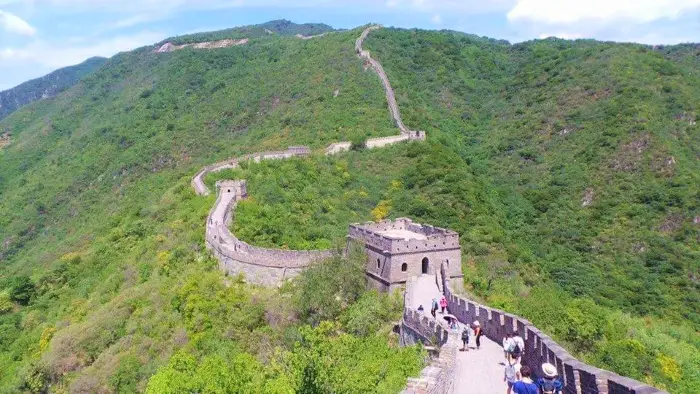
Disclosure: Untold Wanderlust contains affiliate links. If you click on these links and make a purchase, we will earn a small commission at no extra cost to you. You can find our full disclosure policy and privacy policy here.
Great Wall prices at Mutianyu
Before you reach the wall, you will need to go to the ticket office to purchase your tickets. There is a compulsory charge for the entrance to the Great Wall and there are optional transport modes that you can choose from. Below is a breakdown of the different costs.
Mutianyu Great Wall entrance fee
The general admission for the Great Wall at Mutianyu is 40 Yuan for adults, 20 Yuan for seniors, 20 Yuan for Children under 1.4 meters, and FREE for children under 1.2 meters. This cost is compulsory to see the wall. After paying this fee, you can opt to take one of the two hiking trails that lead onto the wall. The hiking trails are free. However, if you wish to take one of the modes of transport, you will need to purchase tickets from the ticket office, at the time of buying your general admissions ticket.
Great Wall Shuttle bus
The shuttle bus will take you to the entrance of the cable car and costs 15 Yuan both ways, or 10 Yuan one-way. The shuttle bus is optional but will save you time and energy; which believe me, you will need to tackle the trek on the Great Wall.
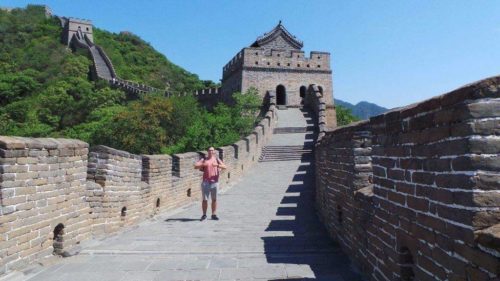
Mutianyu Great Wall cable car cost
The cable car costs 120 Yuan both ways for adults, or 60 Yuan for children, and will take you to Watchtower 14 of 23. The cable car costs 100 Yuan one-way for adults, and 50 Yuan one-way for children.
Great Wall price of the Chair lift
The chair lift is sometimes referred to as the slide rail. It’s the same thing. The cost is 120 Yuan both ways for an adult, and 60 Yuan both ways for a child. One-way tickets are 100 Yuan for an adult and 50 Yuan for a child. The chair lift will take you to tower 6 of 23.
Great Wall toboggan price
To get back to the entrance of the Great Wall, you can opt to slide down on a toboggan. The cost is 60 Yuan one-way. If you have a two-way ticket for the chair lift you can also use this to take the toboggan down. The toboggan is located at Watchtower 6.

Note – you can only take one or the other; cable car or chair lift and toboggan. Both are optional, but you will spend a couple of hours hiking to the wall if you opt for neither.
How to get to the Great Wall from Beijing
Getting to the Great Wall at Mutianyu is very easy and cost-effective for budget backpackers travelling to China. Just follow the steps below:
1. Take bus 916 from Dongzhimen Wai bus station, which costs 30 Yuan one-way. You pay the fare when you board the bus.
2. After around 1 hour, get off at the Haui Rou Bei Da Jaie stop in Huairou District.
3. When you get off, you have two options to reach Mutianyu; the H23 bus which costs 3 Yuan or take a local shared taxi which costs 5 Yuan. The H23 bus gets full quickly, so we recommend spending the extra 2 Yuan and hopping into a taxi to reach the Great Wall at Mutianyu much quicker.
Just a quick tip – be careful of taxi touts jumping on the bus telling you that it’s the stop for the Great Wall. IT IS NOT! Keep on going until you get to the Beidaje stop.
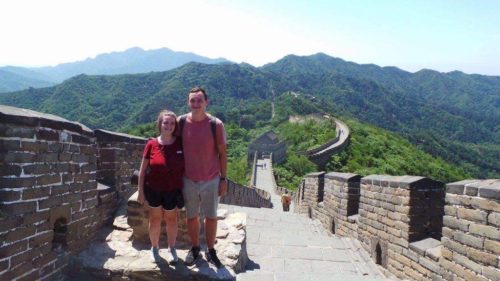
Tips for visiting the Great Wall at Mutianyu
Arrive early – We arrived at the Great Wall at 9:30 am, which was the perfect time as the tour groups didn’t start to arrive until 11:00 am. It also gave us the chance to get some great pictures without herds of people in the shot.
Left of Tower 6 has the best views – We chose to go up on the chair lift and head left (going towards Tower 7). We found that the best views of the wall are between towers 6 and 14.
Drink plenty of water – Make sure to drink plenty of water as the trek can get tiring. You may find yourself feeling dehydrated.
Buy water before entering the wall – Prices for a small bottle of water can rise to a staggering 15 Yuan inside of the wall. Before getting on the shuttle bus there are plenty of shops where you can buy water for 4-5 Yuan.
No more than 5 Yuan for a minivan – When you arrive in Mutianyu you may be offered a lift to the entrance in a mini-van. We chose to use the public bus, but on our way back, we managed to hop into a mini-van for 5 Yuan per person.
Please note that the tips and information we have detailed above are for those who would like to visit the Great Wall independently. If you would like the hassle taken out of getting to the wall yourself, then we recommend booking a guided tour.
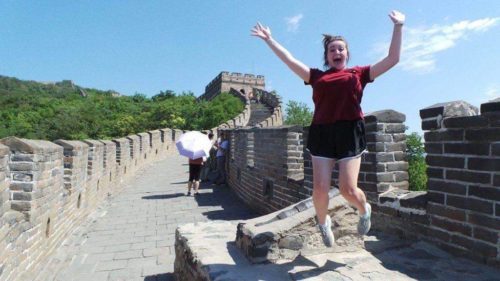
Our experience of the Great Wall at Mutianyu
After a whirlwind time working our way through China, we finally reached Beijing. By which point we were both more than ready to see the Great Wall, our last attraction before we would move onto a Mongolian adventure.
The Great Wall of China is truly a remarkable wonder of the world. It spans over a whopping 21,196.18km, making it difficult to choose where you want to start your much-anticipated trip to the wall. After lengthy trolling through websites and blogs, we chose to head to Mutianyu. We chose this point for two reasons; to avoid the mass crowds at the more popular Badaling entrance, and because of its, somewhat, easy trekking terrain.
Journey to the Great Wall at Mutianyu
The morning we had planned to go to the wall, we had set our alarm clocks for 5:30 am. By 6:000 am we were up, dressed and eagerly ready to leave. The journey to the Great Wall couldn’t have gone any smoother. We managed to find the bus station and get the bus without being ripped off or wasting any time. With a good start to the day so far, we paid the Mutianyu entrance fee and were set to see our first wonder of the world!
The magical moment of stepping on the Great Wall
Upon reaching the wall, after coming off the chair lift, our excitement was beyond words. We had finally made it to stepping foot onto one of the wonders of the world! What first stood out to us, was the sheer length of the wall and how it goes on and on like a never-ending spiral. One of the most fun facts about the Great Wall of China is that it is a whopping 13,000 miles long!
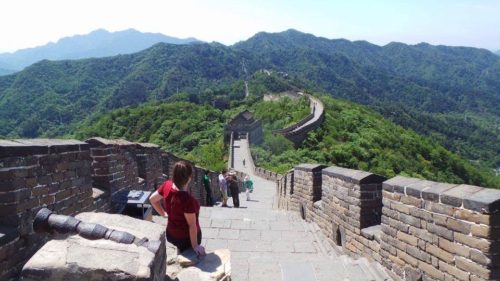
The hilly trekking terrain made for great surprises; after every steep hill, we were met with more and more incredible views. In total, we spent about 3-4 hours walking from Tower 6 to Tower 19 and back. Going up the hills was quite strenuous, particularly under the blistering sun. Whilst walking down the hills, it often felt like our toes were going to poke through our trainers, due to the steepness and our feet getting carried away. Along the way, we found plenty of fantastic photo opportunities. We must’ve stopped about a million times to get some great snaps and to make the most of the empty stairways before umbrella-waving tour groups arrived.
A fun end to the day
All hot, sweaty and tired, we made our way down the Great Wall mountain via the toboggan. Whilst on the toboggan we cooled down with the wind in our hair and rested our tired little feet with a great sense of accomplishment. All in all, our day at the Great Wall couldn’t have gone any smoother. Taking public transport there and back to Beijing was super easy.
Where to stay in Beijing
Feeling luxurious: Asia Hotel Beijing – Offers an indoor swimming pool, garden area and fitness facilities. In a great location for travellers interested in sightseeing.
Budget private room: Beijing Together Hostel – Offers dorms and twin double rooms! Great for couples that want to socialize with others, but also want the privacy of their room.
Dorm life: Lab Hostel – Has a wide range of bed types to choose from and has a great social space. The hostel has a bar that serves cocktails, and a chill zone to watch films.
For the latest prices and deals on other properties in Beijing, CLICK HERE.
Essential resources for travelling in China
Travel Insurance – No matter where you’re travelling to, it’s a good idea to make sure you’re covered for any accidents or losses. We spent days and weeks searching for insurance, but most insurers would not allow us to take out a policy as we were already abroad. Our personal choice is Safteywing . You can opt for automatic monthly payments, just like a subscription. More importantly, it is available in 180 countries and can be purchased whilst already travelling. There is no cap on the duration of travel.
Visa – Before you travel to any country, make sure to check if you need a visa. iVisa is a fantastic website that is super easy and quick to use. Just type in where you are from. and where you are going. to check if you need a visa. If you do, you can quickly make an application online.
Accommodation – Booking.com is our go-to when looking to pre-book accommodation online. Booking.com tend to almost always have the best rates and a FREE cancellation policy for most properties.
Tours & Activities – If you want to book tours and activities online, make sure to check out Get Your Guide . Get Your Guide takes the stress out of booking activities abroad. You will also find a range of benefits, such as skip-the-line passes, lunch included in your tours, and so much more.
Travel tips ebook -Before you head off on your adventure, make sure to download our free ebook. It has a whopping 109 budget travel tips to help you make your hard-earned cash go further. Click here to download your FREE ebook.
We hope this guide to the Great Wall prices at Mutianyu has helped you plan your magical trip to this mind-blowing wonder of the world. The total cost of a trip to the Great Wall of China can be as little as 73 Yuan ($10.40), if you opt to take public transport, and hike to the Great Wall after you have purchased your general admissions ticket.
Want to see more of China’s wonders? Check out the mystical Tianmen Mountain in Zhangjiajie .
Like this post? Pin it!

Leave a Reply Cancel reply
You must be logged in to post a comment.
This site uses Akismet to reduce spam. Learn how your comment data is processed .

- Find a Tour
- China Tours
- Student Tours
- MICE Travel
- Destinations
- Virtual Tours
Great Wall of China

- Travel Guide
- Private Tours
- Sights & Activities
As China's most famous attraction, the Great Wall of China is an essential stop on all China tours . Commonly considered a wonder of the world, the Great Wall boasts a history of over 2,000 years and stretches more than 3,000 miles across several provinces of northern China, making it one of the most impressive ancient structures on the planet.
Virtual Tour of the Great Wall of China
Want to visit the great wall of china spontaneously with a professional live guide learn more about our guided virtual tour here, best sections to visit.
Beijing is usually considered the main gateway to the Great Wall, since there are several world-famous sections of the Wall in the suburbs of Beijing, including Badaling, Mutianyu, Jinshanling, Juyongguan, Gubeikou, and Jiankou. These sections were built during the Ming dynasty between the 14th and 17th centuries and have been well preserved.
Of all the sections of the Great Wall near Beijing, Badaling is the most famous one. As a result, Badaling is the destination of choice for many large tour groups and is often very crowded. The nearby Juyongguan Great Wall features one of the three great mountain passes of the Great Wall but is almost as crowded as Badaling.
Mutianyu Great Wall is just as close as Badaling and offers wonderful views of the Great Wall and the surrounding hills with far fewer tourists. This section of the Wall also features a thrilling toboggan run that you can ride from the top of the Wall down to the bottom of the hill.
Due to their proximity, Badaling, Juyongguan, and Mutianyu are all doable as a half-day trip from downtown Beijing. We usually recommend Mutianyu over Badaling or Juyongguan , since the massive crowds at the latter two sections can ruin one's experience of this impressive structure.
Further away from Beijing, Jinshanling Great Wall is about 150 km northeast of downtown and it usually takes about two and a half hours to drive there. Despite the longer drive, Jinshanling is among the most stunning sections of the Great Wall. If your itinerary allows for one full day seeing the Great Wall, then we highly recommend a tour to Jinshanling.
Gubeikou and Jiankou can also be visited within a day tour from Beijing . Both sections have not been restored since they were first built in the Ming Dynasty, making them ideal choices for those who want to hike and experience the wild Great Wall. Do be aware that the Jiankou section features very steep and dangerous climbs and is only suitable for experienced hikers.
There are also some other famous sections of the Great Wall within or outside Beijing, such as Huanghuacheng, Simatai, and Shanhaiguan, but we only recommend these if you are visiting the Great Wall for a second time or planning a multi-day, in-depth Great Wall tour.
Great Wall Hiking and Camping
Due to its original purpose as a military defense, almost all sections of Great Wall were built on mountain ranges and thus involve some challenging climbs and uneven stairs, including the well-restored sections. If you are visiting a restored section but hike to the end of the renovated part, you will be able to see the unrestored part of the Great Wall.
For most visitors, Mutianyu and Jinshanling offer good, medium difficulty hikes, while still being very safe. For those looking for a serious hike along wild, unrestored portions of the Wall, we suggest the Jinshanling to Jinshanling East , or Gubeikou to Jinshanling routes. All these routes boast both unrestored and picturesque renovated sections of the Wall. However, please be aware that hikes along wild, unrestored parts of the Great Wall involve many steep climbs and loose bricks, and can be very dangerous in some places. (People can no longer hike through from Jinshanling to Simatai since the route was closed years ago.)
Camping on the Great Wall is usually banned, especially on the renovated sections. If you want to spend a night sleeping on the Great Wall , we can take you to a watchtower on the Gubeikou section of the Great Wall to experience the life of an ancient soldier and catch amazing sunrise/sunset views over the Wall.
Best Time to Visit
For all sections of the Great Wall near Beijing, the spring months (April to June) offer temperate weather and are great for climbing. In late April to early May, many trees begin to blossom, making this a particularly beautiful period to visit the Wall. Fall is also a nice time to visit, as temperatures are usually comfortable. October to early November are particularly picturesque, as the tree leaves on the mountains begin to change color. The winter months, from December to February, are cold and can be windy, but there are usually far fewer tourists on the Wall during these months. July and August are hot and humid, and thus not the best for long hikes. In addition, it's best to avoid hiking on the Wall after rain or snowfall because some parts can get very slippery.
You should also avoid visiting the popular sections, such as Badaling, Juyongguan, and Mutianyu, around National Day (the first week in October) and Spring Festival. August is also a busy time for the Badaling and Juyongguan sections, since students are on summer vacation and many families travel to these famous sections with their kids before the new school year starts. Learn more about how to avoid the crowds when traveling in China .
Great Wall of China Private Tour Packages
- Beijing and the Great Wall Day Tour
- 2 days Beijing highlight tour
- 3 days Beijing tour
- Golden Triangle of China - 9 days Beijing, Xian, Shanghai tour
- The Classic China Tour - 13 days Beijing, Xian, Guilin, Yangshuo, Shanghai tour
- The Ancient Capitals - 5 days Beijing, Xian tour
- Tale of Two Cities - 5 days Beijing, Shanghai tour
- More Great Wall tours...
Customize a tour that includes a visit to this destination
Inquiry form.
- 86-19138970032 (GMT+8 18:00~09:00)

- Beijing Xian Tours
- Shanghai Beijing Tours
- Hong Kong Guilin Tours
- Hangzhou Suzhou Tours
- Kunming Lijiang Tours
- Shanghai Yangtze Cruise Tours
- Chengdu Tibet Tours
- More Short Stay Tours
- China Tours in January
- China Tours in February
- China Tours in March
- China Tours in April
- China Tours in May
- China Tours in June
- China Tours in July
- China Tours in August
- China Tours in September
- China Tours in October
- China Tours in November
- China Tours in December

- High Speed Trains
- China Yangtze Cruise Tour
- Photography
- Desert Adventure
- Ethnic Villages
- Biking Tours
- Kung Fu Tours
- Heritage Sites Exploration
- China Spring Tours
- China Summer Tours
- China Autumn Tours
- China Winter Tours
Notice! 2024 available cruise routes include 4~5 days Chongqing-Yichang(most classic) and 11~12 days Chongqing-Yichang-Shanghai(limited).

- Best-value Yangtze Cruises
- Top Family-friendly Cruise Ships
- Top 3 Luxury Yangtze River Cruises
- Yangtze River Highlights
- Yangtze River Cruise Routes
- Upstream or Downstream?
- Dining & Drinking
- Accommodations
- On-board Activities
- Yangtze Cruise Booking Steps

- Inner Mongolia

- Fanjingshan
- How to Plan Your First China Tour
- How to Plan Beijing Tour
- How to Plan Xian Tour
- How to Plan Shanghai Tour
- How to Plan Guilin Tour
- How to Plan Sichuan Tour
- How to Plan Family Tour
- 2024 China Travel Ideas
- Best Time to Visit China
- What to Pack for Your China Journey
- Make Payment in China
- Updated China Travel News
- Ultimate Chinese Visa Guide
- Chinese Visa Types
- Chinese Visa Requirements
- Do I Need a Visa for China
- Chinese Visa Application
- Chinese Visa Exemptions
- 144-hour Visa Free
- Shenzhen Visa on Arrival
- Hainan 30-day Visa Free
- Embassies & Consulates
- Invitation Letter
- Useful Visa FAQs & Tips
- Entry Regulations
- Baggage Allowance
- Customs Declaration
- Exit Regulation
- How to Book Train Tickets
- How to Collect Train Tickets
- How to Cancel & Alter Train Tickets
- How to Read Train Tickets
- China High Speed Train Types
- Seats Class & How to Choose
- Friendly Facilities on the Train
- The Train Station Departure Process
- Available Food and Drinks on the Train
- Western Toilets on the Train
- Luggage Racks & Baggage Allowance
- Beijing Train Stations
- Shanghai Train Stations
- Guilin Train Stations
- Xian Train Stations
- Chengdu Train Stations
- Hong Kong West Kowloon Railway Station
- Beijing - Xian
- Beijing - Shanghai
- Guangzhou - Shanghai
- Shenzhen - Shanghai
- Chengdu - Xian
- Shanghai - Hangzhou
- Shanghai - Xian
- Chengdu - Chongqing
- Kunming - Lijiang
- Beijing Capital International
- Beijing Daxing International
- Shanghai Pudong International
- Shanghai Hongqiao International
- Guangzhou Baiyun International
- Hangzhou Xiaoshan International
- Chengdu Tianfu International
- Chengdu Shuangliu International
- Xian Xianyang International
- Shanghai - Beijing
- Hong Kong - Shanghai
- Guangzhou - Beijing
- Chengdu - Lhasa
- Shanghai - Guilin
- Shanghai - Sanya
- Travel in Spring Season
- Travel in Summer Season
- Travel in Autumn Season
- Travel in Winter Season
- Weather in January
- Weather in February
- Weather in March
- Weather in April
- Weather in May
- Weather in June
- Weather in July
- Weather in August
- Weather in September
- Weather in October
- Weather in November
- Weather in December
- Top 10 China Destinations
- Top 15 Things to Do
- China World Heritage Sites
- Top 10 Best Natural Beauties
- Top 10 Museums in China
- Top 10 Old Towns & Villages
- Five Great Mountains in China
- Top 10 Monasteries & Temples
- Top 10 Ski Resorts
- Top 10 Beautiful Lakes in China
- 7 Best Beaches in Sanya
- Top 6 Beautiful Waterfalls
- Panda Volunteering
- Having fun on Ice and Snow Festival
- About Us Who We Are Our Team Why Travel with Us Feedback & Reviews Travel Stories Travelers' Gallery Payment Guide Customer Support Contact Us
- Tour Experiences
Destinations
- Travel Guide
Great Wall of China Tours 2024/2025
A Beijing tour is not complete without the Great Wall, but a Beijing tour with only Great Wall is not complete too if you escape other MUST-SEEs and MUST-Dos in Beijing, such as the grandiose imperial sites of Forbidden City and Temple of Heaven, royal garden Summer Palace, Beijing’s traditional living dwellings Hutongs, Peking Roasted Duck, Kungfu show, etc. Here are our Best 4 Great Wall Tour Packages from Beijing, which will not only take you to explore the best sections of Great Wall – beautiful and less-crowded, but also cover those other MUST-SEEs and MUST-Dos.
Latest Notice on Great Wall Travel - Updated on May 25, 2023 :
The Beijing Great Wall Protection and Management Regulations clearly state that it is prohibited to organize tours or climb sections of the Great Wall that have not been approved for visitation. Violators may be subject to corresponding fines. The Jiankou Great Wall is an unopened section of the Great Wall, and climbing it can cause damage to the structure. This not only hinders the preservation of the Great Wall but also poses significant risks to the safety of visitors. Therefore, we urge everyone not to climb the Jiankou Great Wall. Tourists can visit and hike at well-developed sections of the Great Wall such as Mutianyu, Badaling, and Jinshanling instead.
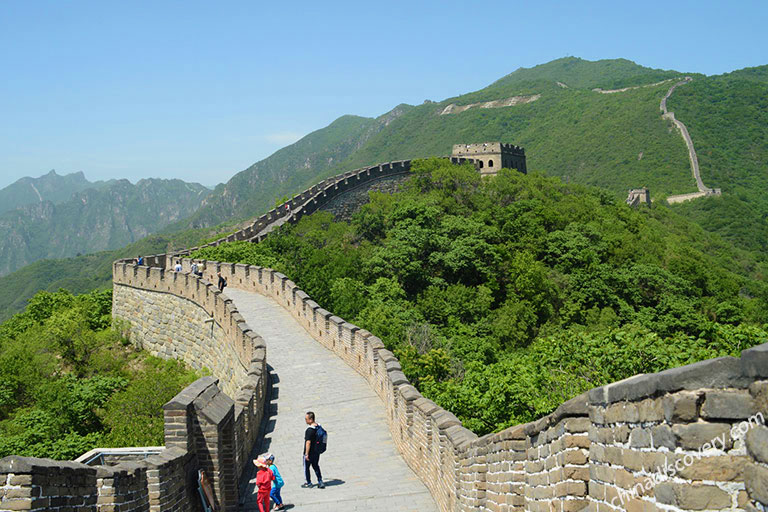
3 Days Visa-free Beijing Essential including Mutianyu Great Wall
Specially designed for travelers who meet the Visa-free Transit Policy in Beijing. Hike the less-crowded Mutianyu section of Great Wall with other famous Beijing attractions.

View Details
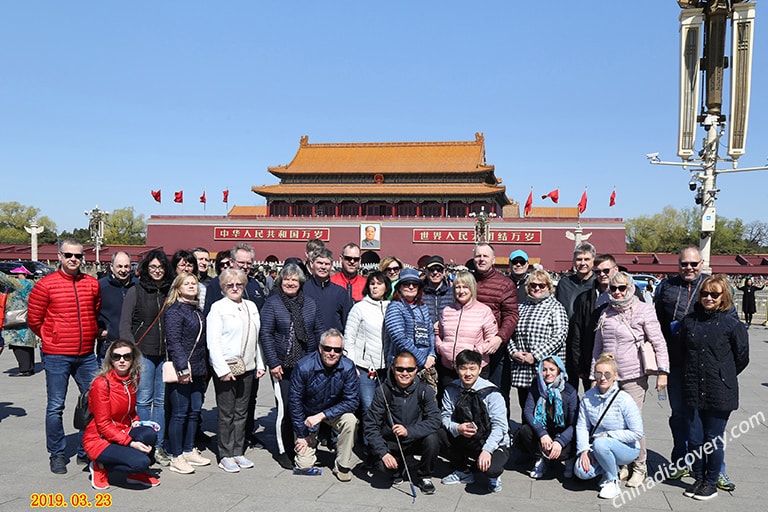
4 Days Most Classic Beijing Tour with Mutianyu Great Wall
Visit the best featured highlights of Beijing and explore the glorious past and present of Beijing in one go, including Great Wall, Forbidden City, Temple of Heaven, Summer Palace, etc.
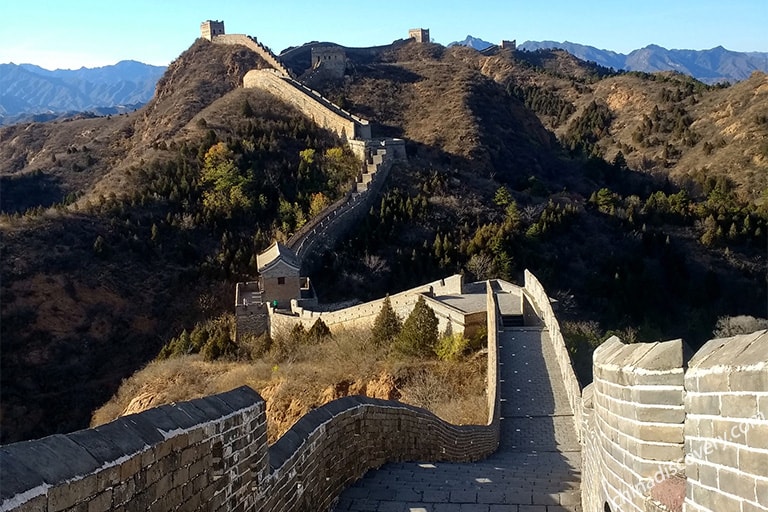
4 Days Beijing Tour with Wild Great Wall Hiking
Get away from the crowds to the wild great wall sections from Gubeikou to Jinshanling, hop on a Hutong rickshaw to feel the old Beijing life style.

4 Days Beijing Simatai Great Wall Night Tour
Hike the most beautiful section of Great Wall - Jinshanling, and take in the peaceful night view of Simatai Great Wall with round-trip cable cars included.

Top 4 Great Walls Only In-depth Tours
The Great Wall of China is not just a single wall to see, actually it consists of many different sections. To experience its more authentic charms, you are suggested to take an in-depth Great Wall trip which includes more different sections of Great Wall. Usually, you can plan a 2 full days trip starting and finishing at Beijing downtown. Hike 1 or 2 sections of Great Wall each day, and stay overnight at a boutique hotel at the foot of the Great Wall, or camp in a watchtower on the Great Wall. What an adventure it is!
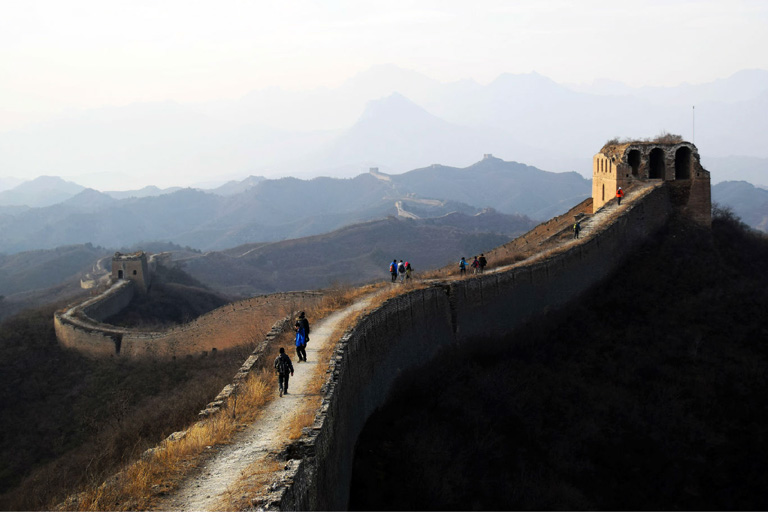
2 Days Wild Great Wall Hiking with Camping Experience
Enjoy a peaceful night during your camping in a watchtower of Gubeikou Section of Great Wall which was the site for over 130 ancient battles.
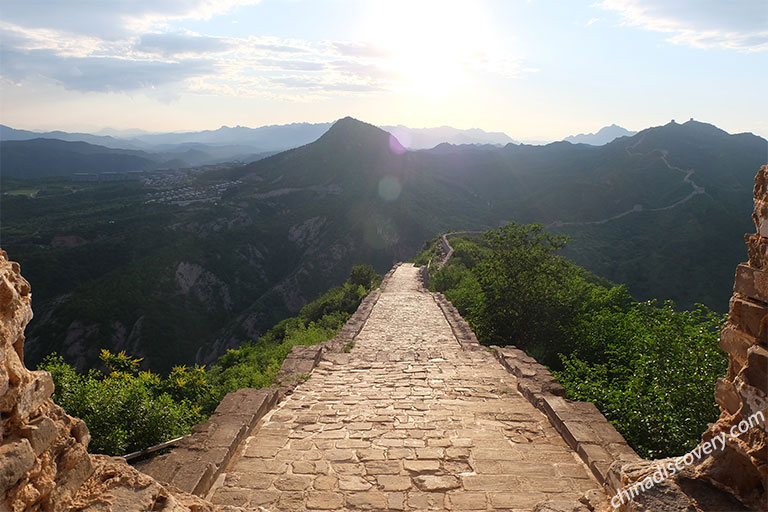
2 Days Wild Great Wall Scenic Hiking
Jinshanling is the most beautiful section of the Great Wall, while Simatai is said to have all the features of other sections of Great Wall.

2 Days Great Walls Adventure Hiking
Enjoy the contrasts of Great Walls during hikes between the magnificent Mutianyu Great Wall and tranquil Huanghuacheng Lakeside Great Wall.
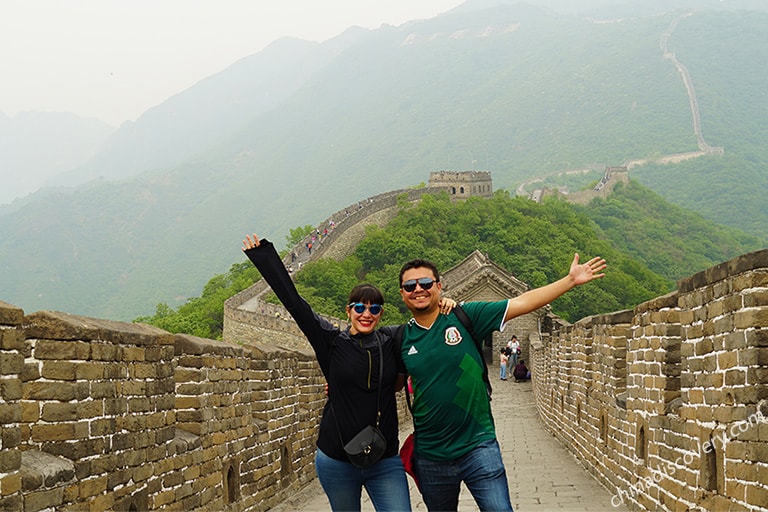
2 Days Mutianyu and Jinshanling Great Wall Leisure Hiking
Mutianyu offers mightiest views of Great Wall. While Jinshanling Great Wall is featured in wild walls, towers, and famous for sunrise and sunset.

Design Your Own Great Wall Tour Package
If you haven't found your favorite section of Great Wall to visit, or haven't found a trip which suits your plan perfectly, please don't worry. We can help you design your own Great Wall experience according to your interest, time and budget. It's only 2 simple steps to go! You can also learn more about Great Wall of China here .
Choose Your Favorite Section of Great Wall to Go

Most popular among foreign travellers. Strongly recommended for first-timers, families with kids and seniors.
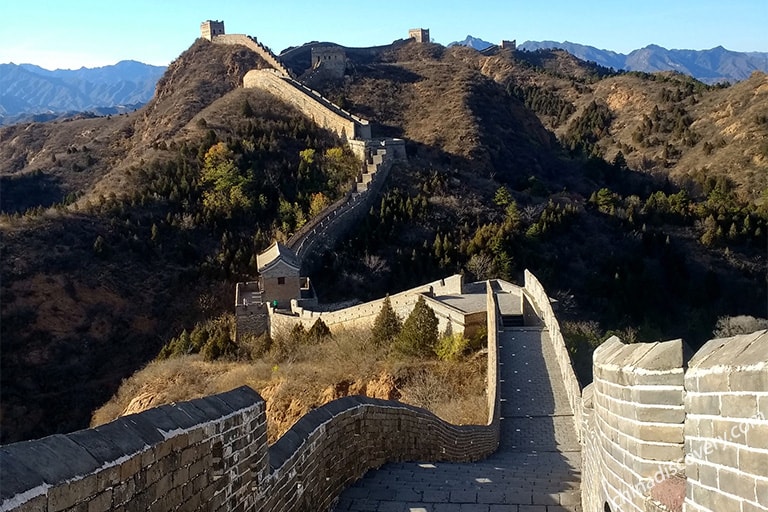
Best for photography and hiking. Recommended to be hiked with Simatai or Gubekou sections of Great Wall.
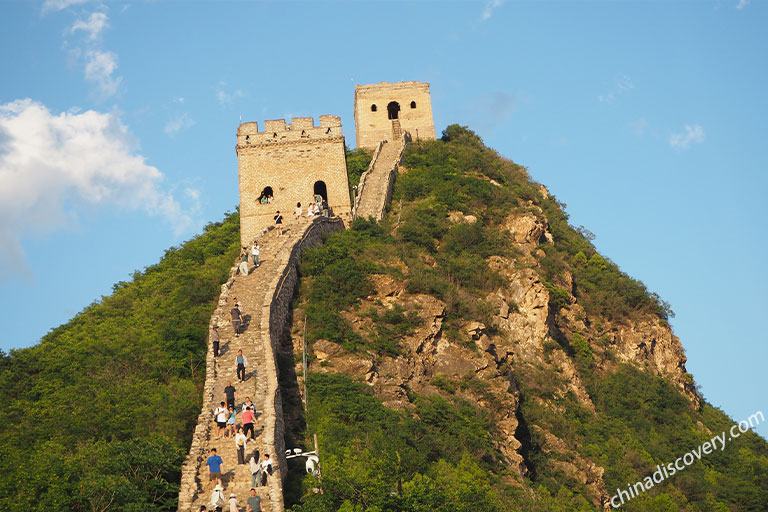
Simatai section is famous for amazing landscape. It is the only section of Great Wall open in the evening time.
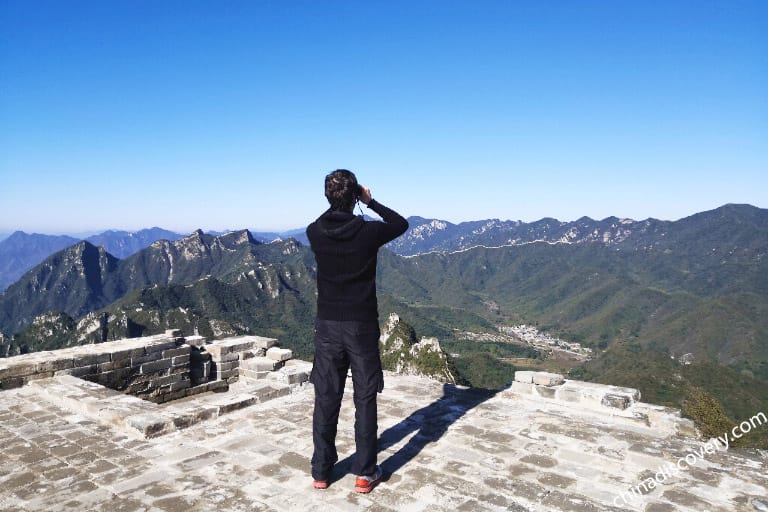
The most dangerous section of Great Wall with a famous hiking route to Jiankou which can be done in 4~5 hours.

Allow tourists to camp for overnight, and take a boat on lake to enjoy Great Wall scenery. Recommended for families.
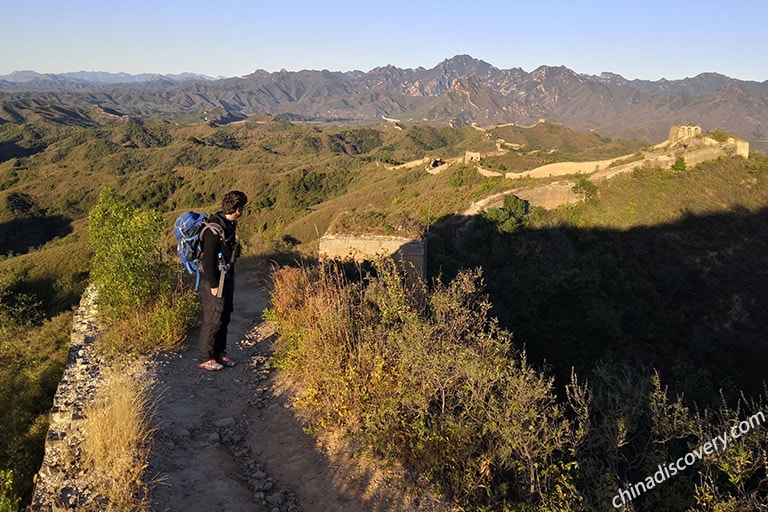
Completely unrestored section of Great Wall. Best site to camp in a watchtower. Can be hiked with Jinshanling Great Wall.
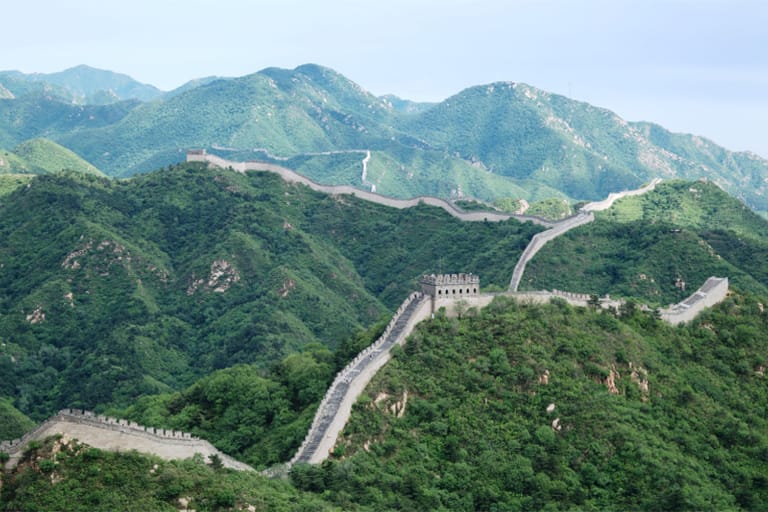
Fully restored section of Great Wall. Usually visited by big tourists groups and Chinese tourists.

Closest section of Great Wall from Beijing. Reccommended for those having a short layover in Beijing.
The Great Walls You Chose are :
Visit Great Wall with Other Popular Beijing Attractions
Choose your favorite attractions in Beijing below to let our travel experts design a reasonable and valuable Beijing trip for you. Most of these attractions are conveniently located at the central city area. Each sight needs only about 1~2 hours to visit.
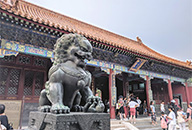
Forbidden City
#4 of 1,619 on Tripadvisor - the royal palaces for Ming and Qing Dynasties for over 500 years.

Summer Palace
#3 of 1,619 on Tripadvisor - the summer resort for the Qing dynasty's royal family.

#41 of 1,619 on Tripadvisor - old folk dwellings, and good place for souvenir shopping.

Temple of Heaven
#5 of 1,619 on Tripadvisor - the largest building for religious worship in China.
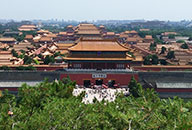
Jingshan Park
#8 of 1,619 on Tripadvisor - good location for photography and Forbidden City panoramic view.

798 Art Zone
#10 of 1,619 on Tripadvisor - old-fashioned factory, numerous galleries and bookshops & cafes.

#16 of 1,619 on Tripadvisor - also known as National Center for the Performing Arts.
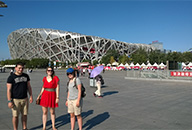
Olympic Park
#21 of 1,619 on Tripadvisor - modern architecture, where the Bird Nest and Water Cube locate.
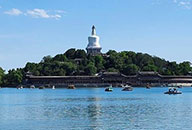
Beihai Park
#11 on Tripadvisor - free local park with a white pogoda. Good for a leisure stroll.
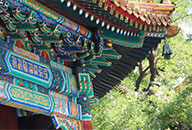
Lama Temple
#12 of 1,619 on Tripadvisor - A series of beautiful Tibetan-style pavilions.

Chaoyang Theater
#13 of 1,619 on Tripadvisor - breathtaking routines of acrobats & gymnasts.
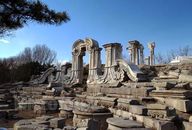
Old Summer Palace
#36 of 1,619 on Tripadvisor - beautiful, historical, and not crowded!
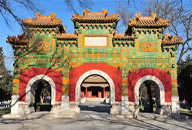
Temple of Confucius
#45 of 1,619 on Tripadvisor - ancient Chinese academy culture, located at Hutong area.
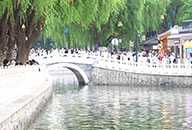
Back Lakes (Hou Hai)
#47 of 1,619 on Tripadvisor - ancient Chinese academy culture, located at Hutong area.
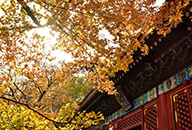
Fragrant Hills
#46 of 1,619 on Tripadvisor - good for summer retreat and autumn red leaves photography.
The Destinations You Chose are :
Contact Us to Complete Your Plan
Please tell us more about your travel plans within just a few simple steps. We'll get back to you with a quotation in 0.5~23.5hrs.
Tell us more about your trip
Tell us about yourself.
- Affordable and valuable price
- 100% tailor-made packages
- Highly rated customers reviews
- Efficient customer support
China Tours
- Top 10 China Tours
- Classic China Tours
- China Tours from Beijing
- China Tours from Shanghai
- China Tours from Hong Kong
- China Tours from Chengdu
- Short China Trips
- Customize China Tour
- China Panda Tours
- Family Tour with Kids
- High-Speed Train Tour
- Silk Road Travel
- Yangtze River Cruise
- Hiking & Trekking Tours
- Photography Tours
- China Minority Travel
- Beijing Shanghai Tours
- Shanghai Yangtze Tours
- Chengdu Jiuzhaigou Tours
- Chengdu Lhasa Tours
- Suzhou Hangzhou Tours
- Guilin & Yangshuo
- Zhangjiajie
“Very good experience”
“WONDERFUL 25 DAYS IN CHINA - PRIVATE TOUR”
“Awesome China tour from northeast to southwest”
Any questions, please email us at: [email protected] or call us at: 86-19138970032 (Monday-Friday 9 a.m. to 6 p.m. GMT+8)
- Terms & Condition
- Privacy Policy
- Customer Support
Copyright © 2011-2024. All rights reserved.
Cookie policy
We use cookies to give you the best experience on our website. Continue using our website means you agree with our cookie policy. For more info, please read here .
- Search Search Search …
- Search Search …

How to Visit The Great Wall of China – [By Public Transport]
The first crucial decision to make when wanting to explore the Great Wall of China, is “Which part of the Great Wall do we want to see?”. And then you need to decide how you want to see it. Getting to the great wall can be as easy as taking a tour from Beijing. So here’s all we learned about how to visit China’s Great Wall, where to see the best parts of the Great Wall, and how to get to the Great Wall by public transport and the easier way to visit the Great Wall of China.
THIS POST MAY CONTAIN COMPENSATED AND AFFILIATE LINKS MORE INFORMATION IN OUR DISCLAIMER
How to Decide which part of the Great Wall to Visit
The Great Wall of China is more than 13,000 miles long. That’s more than 21,000 kilometers. And the easiest place to visit the Great Wall from is the capital of China, Beijing. However, there are five different areas of the Great Wall that it’s possible to visit as a day trip from Beijing, so you need to decide which part to visit.
EASIEST WAY TO VISIT

Visit the Great Wall on an EASY Day Trip
This easy small group English speaking day trip leave from Central Beijing and takes you to the Mutianyu part of the great wall. It’s a great and easy way to see the Great Wall of China.
For us, we scoured TripAdvisor, Lonely Planet, and the GreatWallForum to figure out where we actually wanted to go. Lonely Planet calls out five different areas, and it says that you should avoid Badaling like the plague because that’s the closest to Beijing and thus the busiest. Beijing was where we were visiting the wall from.
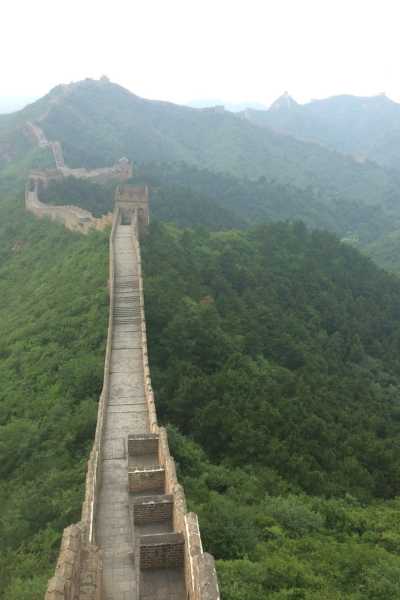
The Main Tourist Areas of the Great Wall
Then you visit all the travel forums and find that it’s pretty much these five area.
- Jinshanling
Consider the weather when visiting the Great Wall
When it came down to it, there was another factor in our visit to the Great Wall and that was the weather. Thunder and rain storms loomed. This would be a blessing to break the horrid sweaty heat that we’d been experiencing, but, rain and the wall don’t mix – as you’ll see from the photos. It’s not that you don’t have those stunning photos and views that you’ve seen on the internet, its more that its hot and wet and slippery.
How to Get to the Great Wall of China?
The options seemed endless. The most common way that folks visit the wall is to get picked up at their hotel and take a minibus or taxi trip to the wall. Easy and efficient from a time perspective. And you’ll get an English-speaking guide (which are few and far between so far on this trip). Here are the best options for tours of the Great Wall of China from Beijing.
We chose to head to the Great Wall at Jinshanling, and we chose to go via public transport. It was definitely an adventure. Here’s how we got there.
How to get to the Great Wall at Jinshanling – Public Transport
Subway to wangfujing.
We took the subway to Line 13 and Wangfujing, despite one woman’s best efforts when we changed lines at Donghuamen to get us to go up top and get a bus to “The Wall”, we made it. We stumbled across the local bus service – which once you know where the bus station is at Wangfujing is obvious. However, arriving at Wangfujing at 0745 when there are tens of buses lined up to take workers to office buildings, it’s not obvious!
Wangfujing to Luiping Bus – get off at Jinshanling Service Centre
From Wangfujing we hopped on a completely full bus to Luiping, to get off at the Jinshanling Service Centre, its first stop 120 km north of Beijing, two hours after getting on.

Jinshanling Service Centre Free Minibus to Great Wall EAST Gate
And then we jumped into the free transfer minibus that takes you to either the East or the West Gate of the Jinshanling part of the Great Wall. We got out at the East Gate, having met Lee, Maria, David, Rosie, and Roberto on the bus. Lee is a Beijinger, who was taking their friend Roberto and couch surfer Maria to the wall for the day. We happily tagged alone and took advantage of his local knowledge.

Costs of Visiting the Great Wall on Public Transport
Visiting the wall isn’t cheap, but if you want to see the Wild Wall, then this is the cheapest way to do it. The subway to Wangfujing will cost 2RMB each way. The bus from Wangfujing to the Jinshanling Service Station is 32 RMB – or if you have a Bejing Subway pass, it discounts it to 20 RMB. The shuttle bus to the East or West Gates of Jinshanling is free. If you can’t wait you can get a taxi, for about 11RMB each.
Entrance to the Jinshanling section of the wall is 65 RMB.
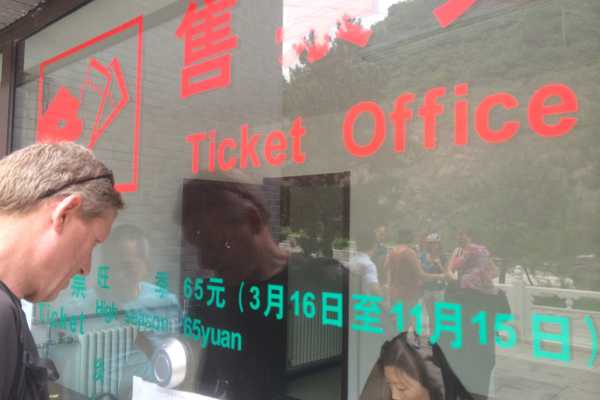
How Long Does it Take to Visit the Great Wall?
We’d arrived at the East Gate at 10:30am, and the shuttle we needed from the West Gate back to the Jinshanling Service Centre left from at 3 pm, This allowed us to catch the last bus back to Wangfujing (Beijing). It was hard to figure out if that was possible or not, as all the maps provided are short on scale to the extent of not showing any!

Hiking up to the Great Wall from the East Gate at Jinshanling
40 heart pumping, leg aching, sweaty minutes later (it was hovering around 95 degrees), we had climbed up to the Wall and arrived at the first tower. Tailed by one of the local vendors, who the rest of the group had decided might feed on the weak first and left her to me. If I didn’t have enough breath for me, there was hardly enough to even say no, let alone yes to her offers of T-Shirts, books, water, and postcards. Besides lady, anything I buy I have to carry, so don’t take it personally, but NO.

Walk out to the EAST – towards Simatai
Instead of turning to the right and heading in the direction of the West Gate of Jinshanling, we headed east, towards the Simatai section. It used to be possible to walk between Simatai and Jinshanling but this connection has been closed since 2010, and while Simatai reopened recently, the connection did not. Our destination was two watch towers hence and then to turn around and retrace our steps.
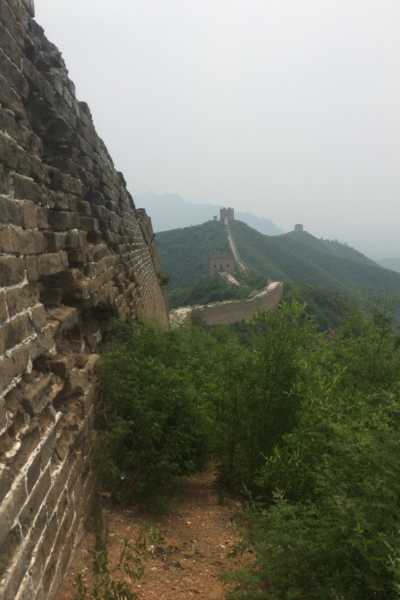
It is nigh on impossible to describe that first step onto the wall. Awe, certainly, disbelief, yes, incredulity even more so. The fact that you’re actually there, and no one else is. Well, the group of us and the vendor lady, but no one else. We’d already lost Rosie and David, so it was just the five of us.
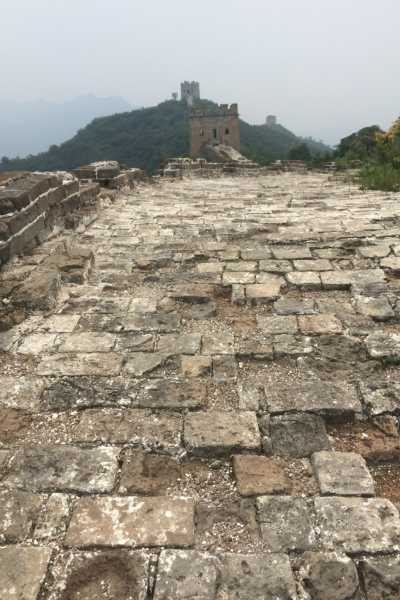
This is the Wild Great Wall
The wall in this area is what they call the wild wall. It’s not been remodeled or manufactured to within an inch of its life like they appear to be doing further west in Jinshanling. It’s rugged, it’s tumbledown in places. It wouldn’t pass a UK Health and Safety examination by any stretch of the imagination. There are no handrails, there are no danger signs, and there’s no one to stop you from going and doing what you want.
Neither is it flat. Oh boy, it’s not flat. Climbing up to the wall is just half of it. Once you get there, it’s up and down on uneven, broken steps and stones. There are watch towers along the way, in varying states of disrepair, on various levels. In our jaunt to Simatai, we clambered around one watchtower, scrambled down through the brush, and then climbed back over the wall, balancing precariously for 20 meters or so along a tumbledown section that was less than 12 inches wide.

Walking, climbing, and scrambling we reached the easternmost tower that we’d visit and took turns standing, on tiptoes, leaning out of the tower for the obligatory photo opportunity, before making the trip westward.

Despite a smoggy day, the vistas are undeniably incredible. THIS IS THE GREAT WALL OF CHINA and I’M STOOD ON IT I feel I wanted to yell. Look at the size of these stones that were all carried up here. Look at the Chinese version of Kilroy was ‘ere inscribed during the building of the wall.
This truly is one of the most amazing Asian landmarks, here’s more to visit.
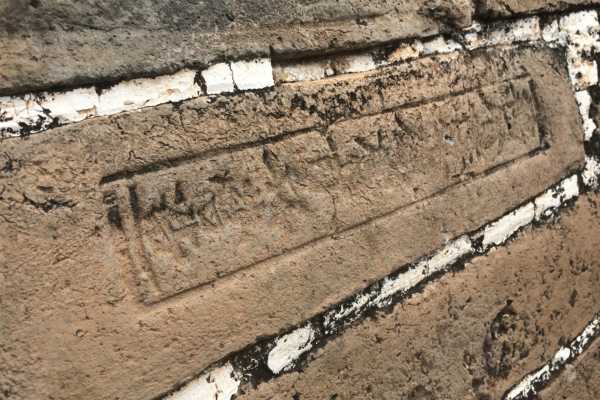
What does it feel like?
It’s hard to put into words what I was expecting. Certainly more people, I had visions of a lot of people, but we were blissfully lonesome for most of the way, except of course as we entered watchtowers, and up there, miles from anywhere, someone had lugged bottles of iced water, coke, even beer, there’s a freezer and if you want noodles, you can get a bowl of noodles too. Who, though, can eat in this heat? Inflation isn’t as bad as I thought it would be, the first tower we hit water was 5 RMB, and by the fifth tower water was 10 RMB. We lived without the noodles and beer.
Heading West towards Jinshanling Again
Time flies by, marked only by steep staircases of crumbling stone that reduce me to crawling up, by more watch towers, by photo stop after photo stop. and the landscape of the wall begins to change. The hills and greenery continue, but the wall becomes more uniform, the stones are flatter, and there are obvious signs of renovation here the closer we move towards the West Gate.
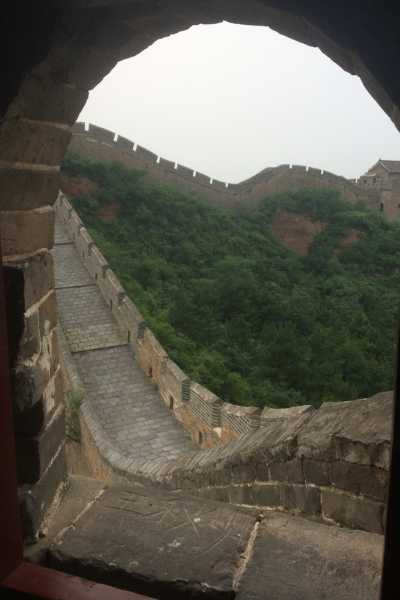
I feel glad that we saw the wild wall, that we started there, but saddened that as we say a last photographic farewell to the wall and start the trek down, we seem to enter a disneyfied, concrete jungle. There is a cable car here – that doesn’t appear to be running – but the entranceway that they’re building and the line management measures that they seem to be putting in place have me glad that we’ve been here now and experienced nature retaking what the Chinese built before they rebuild it.

Travel Tips for Exploring China
- Read our China Travel Check List here
- Considering travel insurance for your trip? World Nomads offers coverage for more than 150 adventure activities as well as emergency medical, lost luggage, trip cancellation, and more.
- Get online immediately with an eSIM for China here.
- Download and install a VPN BEFORE you travel to China > discount coupon here
- Book Transport and Airport Transfers in China here
- Book the best China tours and guides on Trip
- Save money in China with a Wise debit card
- Book Trains in China with Trip
- Book accommodation in China with Trip
UNESCO World Heritage Sites in China
If you like visiting UNESCO World Heritage Sites, then our guides to these Chinese World Heritage sites will be useful
- How to Visit Huanglong National Park [the Yellowstone of China]
- Discover Xian’s Terracotta Army
- How to Visit The Great Wall of China – [Independent Public Transit Route]
- The Forbidden City of Beijing
- The Historic Center of Macau
- Jiuzhaigou National Park
- Huangshan National Park and Sacred Mountain
- Wulingyuan and the Zhangjiajie National Park
- The Sichuan Giant Panda Sanctuaries
- Tiger Leaping Gorge

Final Words on How to Visit the Great Wall of China
It’s hard to imagine going to China and not visiting the Great Wall. It is a magnificent place to visit and for us, all the more so by the fact that we met hardly anyone and that it was an adventure and a half getting there and back.
We receive a fee when you get a quote from World Nomads using our affiliate links. We do not represent World Nomads. This is not a recommendation to buy travel insurance.
ASocialNomad is a participant in the Amazon Services LLC Associates Program, an affiliate advertising program designed to provide a means for sites to earn advertising fees by advertising and linking to amazon.com, amazon.co.uk, and amazon.ca. Amazon and the Amazon logo are trademarks of Amazon.com, Inc. or its affiliates. As an Amazon Associate, I earn from qualifying purchases .
Sarah Carter
Leave a comment cancel reply.
Your email address will not be published. Required fields are marked *
Save my name, email, and website in this browser for the next time I comment.
2 thoughts on “ How to Visit The Great Wall of China – [By Public Transport] ”
- 2 comments
What a wonderful adventure! I was in Beijing several years ago (as part of a Yangtze river cruise) and went bicycling – living on the edge! If you have time (and I think you probably have all the time in the world), you might want to check out Guilin!
Hi! I think you mistook Wangfujing (which is on line 1)! You probably meant Wangjingxi, which is Wangjing West (Metro line 13). Thankfully, I double checked and took the correct exit. You might want to correct the article, so people won’t get lost by mistake 🙂 Best regards!
Privacy Overview
- History Classics
- Your Profile
- Find History on Facebook (Opens in a new window)
- Find History on Twitter (Opens in a new window)
- Find History on YouTube (Opens in a new window)
- Find History on Instagram (Opens in a new window)
- Find History on TikTok (Opens in a new window)
- This Day In History
- History Podcasts
- History Vault
Great Wall of China
By: History.com Editors
Updated: April 18, 2024 | Original: August 24, 2010

The Great Wall of China is an ancient series of walls and fortifications, totaling more than 13,000 miles in length, located in northern China. Perhaps the most recognizable symbol of China and its long and vivid history, the Great Wall was originally conceived by Emperor Qin Shi Huang in the third century B.C. as a means of preventing incursions from barbarian nomads. The best-known and best-preserved section of the Great Wall was built in the 14th through 17th centuries A.D., during the Ming dynasty. Though the Great Wall never effectively prevented invaders from entering China, it came to function as a powerful symbol of Chinese civilization’s enduring strength.
Qin Dynasty Construction
Though the beginning of the Great Wall of China can be traced to the fifth century B.C., many of the fortifications included in the wall date from hundreds of years earlier, when China was divided into a number of individual kingdoms during the so-called Warring States Period.
Around 220 B.C., Qin Shi Huang, the first emperor of a unified China under the Qin Dynasty , ordered that earlier fortifications between states be removed and a number of existing walls along the northern border be joined into a single system that would extend for more than 10,000 li (a li is about one-third of a mile) and protect China against attacks from the north.
Construction of the “Wan Li Chang Cheng,” or 10,000-Li-Long Wall, was one of the most ambitious building projects ever undertaken by any civilization. The famous Chinese general Meng Tian initially directed the project, and was said to have used a massive army of soldiers, convicts and commoners as workers.
Made mostly of earth and stone, the wall stretched from the China Sea port of Shanhaiguan over 3,000 miles west into Gansu province. In some strategic areas, sections of the wall overlapped for maximum security (including the Badaling stretch, north of Beijing, that was later restored during the Ming Dynasty ).
From a base of 15 to 50 feet, the Great Wall rose some 15-30 feet high and was topped by ramparts 12 feet or higher; guard towers were distributed at intervals along it.
Did you know? When Emperor Qin Shi Huang ordered construction of the Great Wall around 221 B.C., the labor force that built the wall was made up largely of soldiers and convicts. It is said that as many as 400,000 people died during the wall's construction; many of these workers were buried within the wall itself.
Great Wall of China Through the Centuries
With the death of Qin Shi Huang and the fall of the Qin Dynasty, much of the Great Wall fell into disrepair. After the fall of the later Han Dynasty , a series of frontier tribes seized control in northern China. The most powerful of these was the Northern Wei Dynasty, which repaired and extended the existing wall to defend against attacks from other tribes.
The Bei Qi kingdom (550–577) built or repaired more than 900 miles of wall, and the short-lived but effective Sui Dynasty (581–618) repaired and extended the Great Wall of China a number of times.
With the fall of the Sui and the rise of the Tang Dynasty , the Great Wall lost its importance as a fortification, as China had defeated the Tujue tribe to the north and expanded past the original frontier protected by the wall.
During the Song Dynasty, the Chinese were forced to withdraw under threat from the Liao and Jin peoples to the north, who took over many areas on both sides of the Great Wall. The powerful Yuan (Mongol) Dynasty (circa 1271-1368), established by Genghis Khan , eventually controlled all of China, parts of Asia and sections of Europe.
Though the Great Wall held little importance for the Mongols as a military fortification, soldiers were assigned to man the wall in order to protect merchants and caravans traveling along the lucrative Silk Road trade routes established during this period.
Wall Building During the Ming Dynasty
Despite its long history, the Great Wall of China as it is exists today was constructed mainly during the mighty Ming Dynasty (1368-1644).
Like the Mongols, the early Ming rulers had little interest in building border fortifications, and wall building was limited before the late 15th century. In 1421, the Ming emperor Yongle proclaimed China’s new capital, Beijing, on the site of the former Mongol city of Dadu.
Under the strong hand of the Ming rulers, Chinese culture flourished, and the period saw an immense amount of construction in addition to the Great Wall, including bridges, temples and pagodas.
Construction on the most extensive and best-preserved section of the Great Wall began around 1474. After an initial phase of territorial expansion, Ming rulers took a largely defensive stance, and their reformation and extension of the Great Wall was key to this strategy.
The Ming wall extended from the Yalu River in Liaoning Province to the eastern bank of the Taolai River in Gansu Province, and winded its way from east to west through today’s Liaoning, Hebei, Tianjin, Beijing, Inner Mongolia, Shanxi, Shaanxi, Ningxia and Gansu.
Starting west of Juyong Pass, the Great Wall was split into south and north lines, respectively named the Inner and Outer Walls. Strategic “passes” (i.e., fortresses) and gates were placed along the wall; the Juyong, Daoma and Zijing passes, closest to Beijing, were named the Three Inner Passes, while further west were Yanmen, Ningwu and Piantou, the Three Outer Passes.
All six passes were heavily garrisoned during the Ming period and considered vital to the defense of the capital.
Significance of the Great Wall of China
In the mid-17th century, the Manchus from central and southern Manchuria broke through the Great Wall and encroached on Beijing, eventually forcing the fall of the Ming Dynasty and beginning of the Qing Dynasty.
Between the 18th and 20th centuries, the Great Wall emerged as the most common emblem of China for the Western world, and a symbol both physical—as a manifestation of Chinese strength—and a psychological representation of the barrier maintained by the Chinese state to repel foreign influences and exert control over its citizens.
Today, the Great Wall is generally recognized as one of the most impressive architectural feats in human history. In 1987, UNESCO designated the Great Wall a World Heritage site, and a popular claim emerged in the 20th century that it is the only manmade structure visible from space ( NASA has since refuted this claim ).
Over the years, roadways have been cut through the wall in various points, and many sections have deteriorated after centuries of neglect. The best-known section of the Great Wall of China—Badaling, located 43 miles (70 km) northwest of Beijing—was rebuilt in the late 1950s, and attracts thousands of national and foreign tourists every day.

Sign up for Inside History
Get HISTORY’s most fascinating stories delivered to your inbox three times a week.
By submitting your information, you agree to receive emails from HISTORY and A+E Networks. You can opt out at any time. You must be 16 years or older and a resident of the United States.
More details : Privacy Notice | Terms of Use | Contact Us
National Geographic content straight to your inbox—sign up for our popular newsletters here
- WORLD HERITAGE
See China’s Iconic Great Wall From Above
This is one of the world’s greatest feats of engineering.
China’s iconic Great Wall, actually a network of fortifications rather than a single structure, is the product of countless labors over a period of some two thousand years. Qin Shi Huang took the remnants of truly ancient fortifications, walls, and earthworks begun in the fifth century B.C. and linked them into a unified wall circa 220 B.C. as part of a massive project to protect China against marauding barbarians from the north.
By the time construction on most of the stone-and-brick Great Wall, with its turrets and watchtowers, was completed during the Ming dynasty (1368-1644) the chang cheng had become the world’s largest human-made object.
A recent government mapping project revealed that the entire Great Wall structure spans some 5,500 miles (8,850 kilometers) from the Korean border west into the Gobi desert. Of that total 3,889 miles (6,259 kilometers) were actual wall, while 223 miles (359 kilometers) were trenches and (1,387 miles) 2,232 kilometers were natural defensive barriers, like rivers or steep hills, incorporated into the system.
Though new sections of the wall have recently been uncovered, several sections of the structure have vanished during the past half century or so. Mao Zedong himself encouraged destruction of parts of the wall and reuse of its materials in the 1950s, and rural farmers still make use of the wall’s earth and stone for practical purposes.
Some 50 percent of the original ancient structure has already disappeared, and perhaps another 30 percent lies crumbling into ruins—even as Chinese and international organizations struggle to preserve what remains of this unique treasure.
21 of China's Most Spectacular UNESCO Sites

How to Get There
tourists explore the wall from Beijing. The most popular section (Badaling) is 42 miles (70 kilometers) from the city. This section boasts impressive views, and with crowds come all the modern trappings of development. Those seeking less popular or unrestored sections of the wall have many suitable choices within easy driving distance of Beijing.
The wall has endured centuries of seasons and remains ready to host visitors year round. The Beijing region has icy winters, but the hardy will find far fewer crowds than during the peak summer seasons. Autumn is often delightful near Beijing with mild weather (43° to 64°F/6° to 18°C) and reduced tourist crowds. Wind and dust can be common in springtime. China is a nation of festivals, so consider timing a visit to coincide with a celebration in the shadows of the wall.
- Nat Geo Expeditions
How to Visit
As is appropriate for a monument so massive, there are many ways to visit the wall. Some visitors aspire to admire the views from popular tourist sections, pose for pictures, walk the wall, and take advantage of amenities from restaurants and shops to cable car rides. Others choose to explore rugged sections of the structure on extended hikes and climbs of unrestored “wild wall” sections, though these can be dangerous and are often located in rural areas well off the typical tourist path.
Related Topics
- WORLD HERITAGE SITES
- ENGINEERING
- ANCIENT CIVILIZATIONS
You May Also Like

See these 6 architectural wonders before they disappear

20 of the coolest travel adventures for 2024

Carthage was Rome’s greatest rival. Go see its side of the story.

This ancient marvel rivaled Rome’s intricate network of roads

See the summer solstice from a Roman emperor’s party cave
- Environment
History & Culture
- History Magazine
- History & Culture
- Coronavirus Coverage
- Mind, Body, Wonder
- Paid Content
- Terms of Use
- Privacy Policy
- Your US State Privacy Rights
- Children's Online Privacy Policy
- Interest-Based Ads
- About Nielsen Measurement
- Do Not Sell or Share My Personal Information
- Nat Geo Home
- Attend a Live Event
- Book a Trip
- Inspire Your Kids
- Shop Nat Geo
- Visit the D.C. Museum
- Learn About Our Impact
- Support Our Mission
- Advertise With Us
- Customer Service
- Renew Subscription
- Manage Your Subscription
- Work at Nat Geo
- Sign Up for Our Newsletters
- Contribute to Protect the Planet
Copyright © 1996-2015 National Geographic Society Copyright © 2015-2024 National Geographic Partners, LLC. All rights reserved
- Important Events
- Aerial View
- Virtual Tour -1
- Virtual Tour -2
- Virtual Tour -3
- How to Get There
Opening Hours
- Notice to Visitors
- Study-tour Activities
Recommended Routes
- Architecture
Foreign Affairs Reception
- Celebrity Reception
- Domestic Reception
- Great Wall Spirtual Exhibition Hall
- Ticket Purchase Instructions
- Refund Guide
- Tour Guide Service
Cultural and Creative Products

Mutianyu Great Wall
The exquisite construction techniques and advanced military defense ideas shows the wisdom of ancient Chinese people, "harmony between heaven and man".
Monday to Friday 7:30-18:00
Peak season:
March 16th to November 15th
Off-peak season:
November 16th to March 15th of the following year
Happy May Day Holiday!
Today, we honor workers worldwide for their dedication and contributions to society. Let's express gratitude to essential workers on the frontlines. Take a moment to appreciate their hard work. Enjoy a well-deserved break!
"Ascend Mutianyu to be a real hero" limited edition medals now available
Embark on a journey of bravery and glory at Mutianyu Great Wall with the limited edition "Ascend Mutianyu to be a real hero" medal. Crafted with high-quality metal, it symbolizes courage and honor. Only 1000 available, each box includes a medal and certificate for 199 yuan. Purchase at select locations for a chance to own this unique souvenir and enjoy exclusive discounts. Capture your heroic moment and make history at the top of Mutianyu Great Wall.
Long-awaited trial operation of Great Wall night tour about to come back!
Experience the beauty of Mutianyu Great Wall this May Day with extended night tours until 22:00. Enjoy cable car rides, movies, performances, and more. Tickets available via official channels. Green travel recommended. Follow safety guidelines and prepare for changing weather. For transportation, consider public buses or self-driving with parking at the service area. Plan ahead and enjoy a memorable visit. Contact hotline for details.

The Great Wall of Beijing in eyes of foreigners during Qing Dynasty | William Edgar Geil

A group of Romanian artists visit Mutianyu Great Wall
Experiences.

Great Wall Study-tour Activities
The Great Wall is a symbol of China and an architectural wonder of the world. The construction of the Great Wall spanned two thousand years. There are too many hidden knowledge and stories waiting for us to explore and feel.

Great Wall Banquets
Indulge in a lavish feast amidst the breathtaking backdrop of Mutianyu Great Wall, creating an unforgettable experience for your special occasion.

Great Wall Parties
When the magnificent scenery of the Great Wall collides with the vibrant and joyful atmosphere.When dynamic music and unrestrained laughter mixAn unprecedented experience is coming to you.A colorful party on top of the Great Wall.Here you can play and revel unrestrainedly, which is a kind of ultimate enjoyment.

In order to better promote the protection of the Great Wall and Chinese historical relics, the scenic area has held various public welfare activities.

Great Wall Weddings
Say "I do" in a fairytale setting where love and history intertwine at Mutianyu Great Wall, creating a wedding day that will be etched in your hearts forever.
Scenic Views
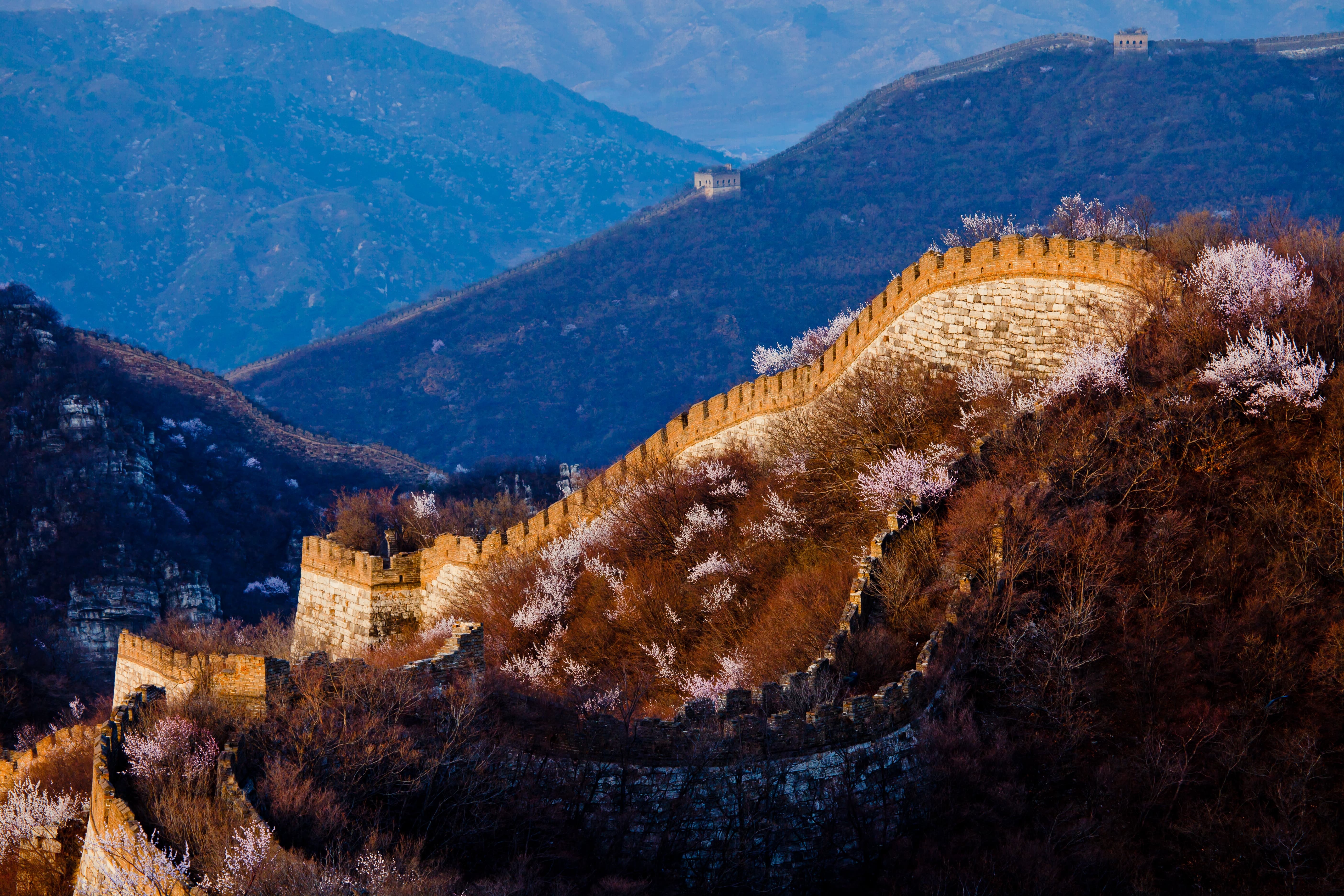
Mountain flowers
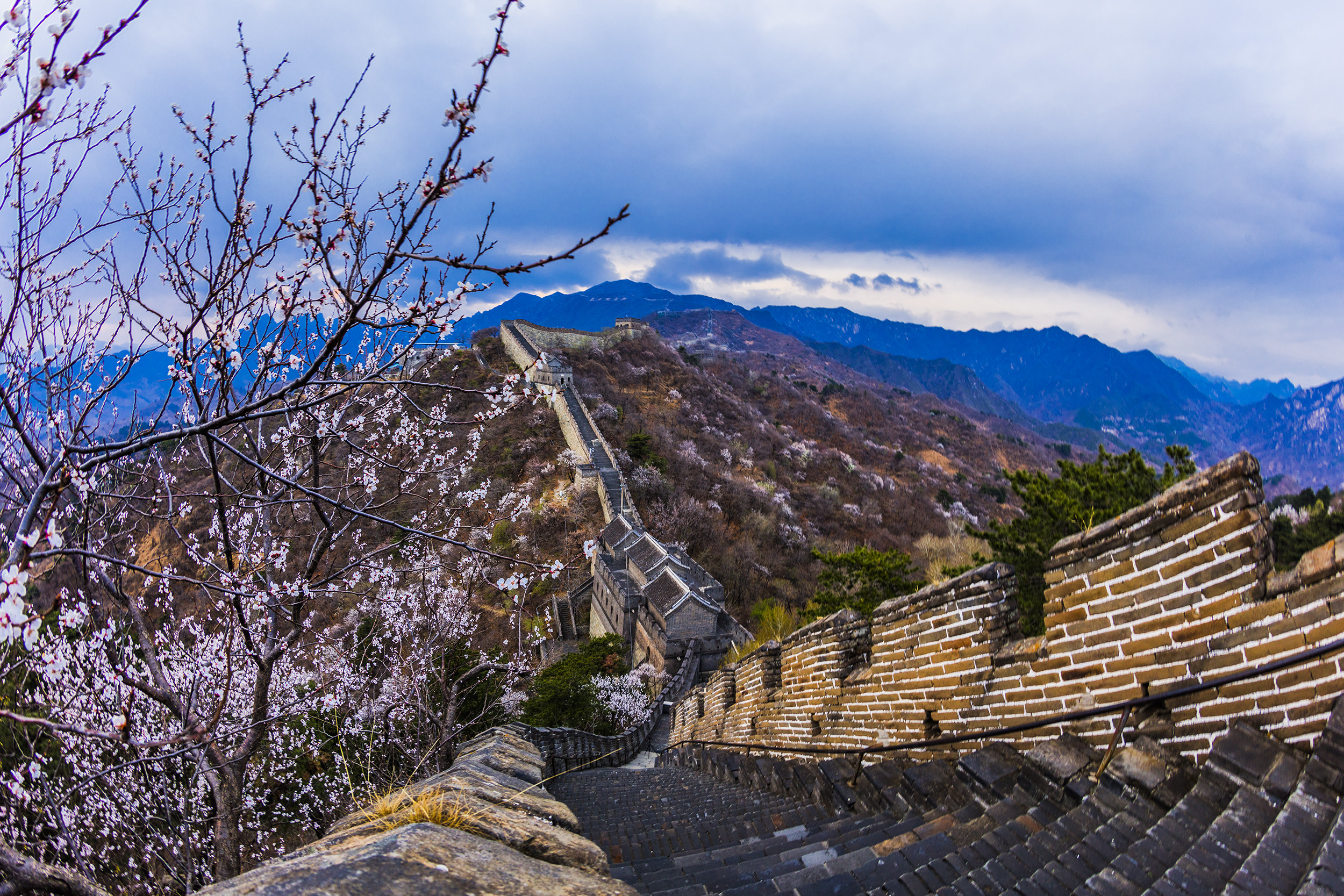
2024 Night Tour to be launched at Mutianyu Great Wall

2024 Mutianyu Great Wall Mountain Flower Festival officially kicks off

【Romantic Getaway】Two-Day Trip
Embark on a romantic getaway in the surrounding areas of Mutianyu Great Wall. Start your trip by visiting Huanghuacheng Lakeside Great Wall, a scenic destination that combines mountains, clear waters, and the ancient Great Wall. Check into the Mutianyu Great Wall Hotel and indulge in exquisite local dishes. On the second day, witness the sunrise at Mutianyu Great Wall and spend the day exploring. Enjoy a delicious lunch at Yisonglou Restaurant within the scenic area. Afterward, visit Xiangshui Lake, a picturesque valley that combines the Great Wall, ancient caves, mountains, and water features. Explore Shengquan Temple, a renowned pilgrimage site for Guanyin, known for its stunning natural landscapes and tranquil environment. Immerse yourself in ancient rituals and cultural exploration.
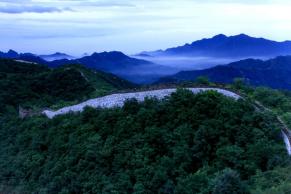
【Indulge in Self-driving】Free Ride
Avid self-driving is an attitude and a way of life. It means to be brave to challenges, to face setbacks, to be indomitable and to finally reach the top.
【Explore Fun】One-Day Trip
Mutianyu Great Wall Scenic Area is a well-preserved section of the Great Wall of China, built in 1368. It stretches from Gubeikou to Juyongguan and served as a strategic military defense. The area features famous landmarks such as Zhengguantai, Dajiaolou, and Yingfeidaoyang, reflecting the ancient charm of the Great Wall. Visitors can enter the scenic area after passing through the commercial street and taking a shuttle bus. After visiting, they can have lunch at the Mutianyu Great Wall Hotel. Surrounding attractions include Yanqi Lake, offering various water and land entertainment activities, Qinglong Canyon, a resort for sightseeing and leisure, and Hongluo Temple, a magnificent ancient temple surrounded by mountains and forests.
【Photography Journey】Great Wall Culture
This recommended photography route combines the interests of professional photography enthusiasts and regular tourists. Start at Mutianyu Great Wall to capture the sunrise and highlights of the Great Wall. Visit the International Cultural Village for cultural inspiration and capture the sunset. Next, explore the "Hidden Village in the Deep Mountains" in Bohai Town, known for its simple rural scenes. Continue to the Cliff Stone Scenic Area, featuring historical imitations, cliff carvings, and eco-hotels. Finally, visit Xiangshui Lake Scenic Area, passing by the stylish Xiangshui 008 homestay, known for its outdoor camping and sustainable practices. Enjoy the campfire, food, and tranquil atmosphere while capturing beautiful moments with your camera.
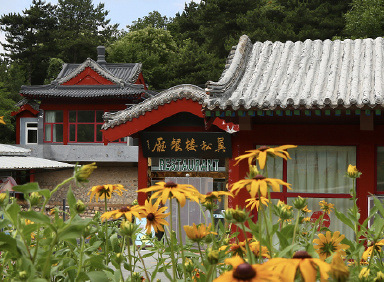
Yisonglou Restaurant

Mutianyu Great Wall Hotel

- Beijing Volunteer Service Federation
- The Palace Museum
- National Museum of China
- TheGreatWall.com.cn
- Prince Kung’s Palace Museum
- Yuanmingyuan Park
Follow us on
86-10-61626022
京ICP备12009346号-1 © 2020- Beijing Mutianyu Great Wall scenic spot
- Skip the line to guarantee your entry.
- Enter simply by scanning your passport, no need to collect a paper ticket.
- A must-visit landmark on travelers’ bucket list.
- Beat the long lines for purchasing tickets, hassle-free for tourists with a tight schedule.
- A must-see UNESCO World Heritage Site for first-time visitors and history buffs.
- Explore the emperors’ backyard.
- Learn about royal worship ceremonies of Ming and Qing Dynasties.
- The largest ancient architectural complex for worshipping heaven in the world.
- Avoid long lines to buy tickets at the entrance.
- Beat the crowds by purchasing the Badaling Great Wall tickets in advance.
- Guarantee your entry as the Badaling Great Wall allows only 65,000 visitors a day.
- Free change and cancellation as long as you send the request before deadline.
- Explore one of the most beautiful but less crowded sections of Great Wall.
- Skip the queue to buy tickets on site.
- Enter directly by scanning the QR code generated when booking - physical ticket NOT required!
- An amazing visual feast integrating Chinese acrobatics, classical dance and music.
- A perfect thrilling experience for all ages.
- Marvel at the second-to-none stunts.
- Top of “World’s 25 Scenic Spots You Cannot Afford to Miss" by The Times
- Architectural relics of Ming Dynasty in the most original appearance
- Mountains ablaze with color of fall foliage
- Closely watch lovely rare animals such as pandas.
- Learn some common knowledge about animals.
- It's the earliest and largest city zoo in China.
- Witness the falling of flourishing Qing dynasty from the thoroughly ruined gardens and severely burnt palaces
- Enjoy the most spectacular sunset in a peaceful afternoon
- Purify your spirit by viewing a colorful and spectacular scenery
- The most magnificent pass in the world
- On list of the Eight Famous Scenic Spots in Beijing
- A chance to challenge one of the most precipitous parts of China Great Wall
- "Great Wall under water", a miracle that you surely do not want to miss
- Leisure time on boat with friends and family, fits people at all ages.
- No fight with crowds and enjoy your peaceful time
- Immersed in the paradise of cherry blossom in spring
- Close your eyes and feel a refreshing summer breeze blowing across the lake
- Have quite a lot of fun of playing games outside on ice and snow in winter
- A time-honored royal garden with a history of nearly 1,000 years.
- Convenient transportation as it is in the city center of Beijing.
- Suitable for travelling in all seasons.
- A God-given angle for panorama of Forbidden City
- Learn the beauty of Chinese architecture with no crowds
- Immerse in the sea of peonies and tulips
- Taste the grandeur of the royal garden
- See the most impressive autumn view of red leaves
- A perfect site for summer holiday
- Appreciate elaborately selected Peking Opera excerpts without language barriers.
- Take in China’s traditional culture through authentic Peking Operas.
- Have a chance to see how Peking Opera performers make up.
- Customer Reviews
- Questions & Answers
How to Get to the Great Wall from Beijing
In this article, we provide you with up-to-date (April 2019) insider information about how to get to two famous sections of the Great Wall of China (Mutianyu and Badaling) from Beijing city center and Beijing airport by taxi, S2 train, bus, and transfer services included in our Beijing Great Wall tours, including costs for each.
Where the Great Wall of China Is Located
The Great Wall of China winds across mountain ridges along what were once the northern borders of ancient China. It has existed for over two thousand years and its total length is over 21,000 kilometers.
Beijing has the 10 best sections of the Great Wall . It is worth visiting the sections that are located in its suburban areas.
The two most popular sections of the Great Wall are Mutianyu and Badaling . These are, respectively, the most fully-restored section of the Great Wall and the most famous section.
They are both located some 70 kilometers north of Beijing city center. Learn more about Badaling Versus Mutianyu: Which One Should I Visit?
(This map shows the distance and time costs to Mutianyu and Badaling Great Wall from Beijing City by taxi.)
How to Get to the Great Wall at Mutianyu from Beijing City
The Mutianyu section of the Great Wall is located 73 kilometers (45 miles) from Beijing city center, taking 2 hours to get there by taxi. You can also get to the Mutianyu section in a tourist bus or with a transfer service included in our Beijing Great Wall tours.
Option 1. By Taxi (2 Hours, $37)
It costs about 250 yuan ($37) with the toll fee included each way to get to the Great Wall at Mutianyu scenic area from Beijing city center. It;s a 2-hour drive if you don't encounter any traffic controls or jams.
Show the taxi driver this Chinese message: 请带我去慕田峪长城景区. It means: Please take me to the Great Wall at Mutianyu scenic area.
Opening times and fees for the Great Wall at Mutianyu: The scenic area at the Great Wall at Mutianyu opens from 7:30 am to 5:30 pm all year round. The entrance fee is 45 yuan.
Option 2. By a Transfer Service Included in Our Great Wall Day Tours (Tour Starts from $159)
The tours usually offer: A spacious car , An English-speaking guide , Collection from your hotel lobby / the airport according to your schedule,The must-see attractions, such as Tian;anmen Square , the Forbidden City , and the Great Wall (either section of the Great Wall and a cable car trip included both ways), Lunch (optional), Entrance fees to listed sites, A return drive to your hotel or the airport .
Inquire about our Great Wall Day Tour - they are all customizable according to your preferences.
Option 3. By Tourist Bus (60 Yuan / $9 Both Ways)
At present, there is only one tourist bus route heading to the Great Wall at Mutianyu from Beijing city center. It starts from Qianmen tourist dispatch center, passes Dongzhimen, and ends at the front gate of the Great Wall at Mutianyu scenic area.
Passengers can purchase tickets at the Beijing Hub of Tourist Dispatch Centers (北京旅游集散中心) in either Qianmen or Dongzhimen , or you can book your ticket(s) via their official websites in advance.
- The departure time from Qianmen is between 7:30 am and 8:30 am every day. The coach will set off when it is full.
- The ticket fare is 60 yuan / $9 for both ways. The journey to the Great Wall at Mutianyu takes about 2 hours and will allow you to explore the Great Wall on your own for 4 hours after getting there.
- Then you need to head back before 3:30 pm as the last bus going back to town sets off at 4 pm.
- Excluded: Vouchers to have lunch on the Great Wall and the cable car fees.
Why a Tourist Bus is NOT the Best Option
- For foreign tourists, locating the tourist dispatch center can be quite a challenge , not to mention the language barrier when dealing with the purchasing process either on the spot or online (the official website doesn;t have an English version at present).
- The departure times of the bus are not flexible , which isn;t good for tourists with limited time in Beijing, especially those with layovers.
- During weekends, national holidays, and summer/winter school vacations, the bus tickets are likely to be sold out very quickly , and booking them via the website in advance is rarely possible.
Option 4. By Public Bus 916 Then Change to H23(Not Recommened)
There were options to take subway Line 2 to Dongzhimen, then to take public bus 916, and then bus H23/H50/H35, and get off at the Great Wall at Mutianyu. However, H50 and H35 have been out of service since the tourist shuttle bus services started to operate recently.
- 5-Day Beijing Family Tour
- One Day Beijing Highlights Private Tour
How to Get to the Great Wall at Badaling from Beijing City
The Great Wall at Badaling is located 72 kilometers northwest of Beijing city center, taking 1½ hours to get there by taxi . You can also get to the Great Wall at Badaling by S2 train and will be able to get there in a bullet train by 2020 .
Option 1. By Taxi (1½ hours, $36)
It costs about 240 yuan ($36) with the toll fee included each way to get to the Great Wall at Badaling scenic area from Beijing city center. It takes 1½ hours to drive there if no traffic controls or jams are encountered.
Show the taxi driver this Chinese message: 请带我去八达岭长城景区. It means: Please take me to 'Badaling Great Wall Scenic Area;.
The tours usually offer: A spacious car , An English-speaking guide , Collection from your hotel lobby / the airport according to your schedule, The must-see attractions, such as Tian;anmen Square, the Forbidden City, and the Great Wall (either section of the Great Wall and a cable car trip included both ways), Lunch (optional), Entrance fees to listed sites, A return drive to your hotel or the airport.
Take a look at our popular Beijing Great Wall Day Tours , they are all customizable according to your preferences.
- Beijing Great Wall Layover Tour (10+ hours)
- Beijing Highlights Tour (1 day: Tian;anmen Square, the Forbidden City, lunch, the Great Wall with cable car access)
3. By S2 Train (2½ hours, $2)
Travel to Huoying (霍营) Station either on subway Line 8 or 13, or take the Airport Express line .
Exit the station and go to Huangtudian Railway Station (黄土店火车站) nearby, then take the S2 train and get off at Badaling Railway Station.
The entrance to the Great Wall at Badaling is a 20-minute walk from the railway station. You can follow the flow of other passengers or be guided by the signs along the roads, which are written in both English and Chinese .
There are free shuttle buses from the railway station to the cable car station at the Badaling section of the Great Wall although you have to queue for a while to get one of these.
Essential Information about Taking the S2 train to the Great Wall at Badaling
- Fare: 7 yuan
- Frequency: Eight pairs of trains operate during weekdays while 12 pairs operate during national holidays and weekends.
- Duration: 1½ hours
- In service: 7:45 am to 10 pm (these times are liable to change without notice due to passenger flow adjustments)
Opening times and fees for the Great Wall at Badaling: The Great Wall at Badaling scenic area opens from 6:30 am to 5:30 pm during the peak season and from 7:30 am to 4:30 pm during the off season. The entrance fee is 45 yuan during the peak season and 40 yuan/trip for the cable car.
Option 4. By Tourist Bus (40 Yuan / $6 Both Ways)
There is one tourist bus route heading to the Great Wall at Badaling from Beijing city center. It starts from Qianmen tourist dispatch center and ends at the front gate to the Great Wall at Badaling scenic area.
Passengers can purchase tickets at Qianmen tourist dispatch center 30 minutes before departure or via their official website.
- Departure time : Between 7 am and 11 am every day. The coach sets off when it is full.
- Ticket fare: 40 yuan / $6 each way. The journey takes about 2 hours to reach the Great Wall at Badaling.
- The last bus back to town sets off at 3:30 pm.
- Excluded: lunch, the Great Wall tickets, and cable car fees.
Why a Tourist Bus is NOT the Best Option: Similar to the main reasons why a tourist bus to Mutianyu is not recommended, as mentioned above, you will have difficulty locating the dispatch centers , be hampered by the language barrier , be restricted to fixed departure and return times , and discover that the tickets rapidly sell out .
Option 5. By High-Speed Train (20 Minutes)
The new Badaling railway station for high-speed trains has been completed. Bullet trains departing from Beijing North Railway Station can reach the Great Wall at Badaling in 20 minutes.
Option 6. By Bus (14 Yuan, 3 Hours - Not Recommended)
You can get on bus 5 at Tian;anmen East Station (天安门东站) and change to bus 919 at the Madianqiaonan stop (马甸桥南站), then get off at the stop for Badaling National Forest Park to reach the Great Wall at Badaling. For foreign tourists, it;s difficult to locate the stops and easy to take a bus going in the wrong direction .
- 6-Day Beijing Chinese New Year Tour
- 1-Day Beijing Hutong Tour
Getting to the Great Wall from Beijing Capital International Airport
If you wish to have a short visit to the Great Wall from Beijing Capital International Airport (PEK), we recommend you go to the Mutianyu section as it is closer to the airport as well as being equally famous and interesting.
Option 1. By Taxi
The Mutianyu section of the Great Wall is located 54 kilometers (34 miles) north of Beijing Capital International Airport. It takes about 1½ hours to get there by taxi and costs about 180 yuan ($27) each way , including the toll fee.
As a comparison, a taxi from Beijing airport to Badaling , which is located 73 kilometers (45 miles) to the northwest, will take about 2 hours by taxi and cost about 280 yuan ($42) each way .
If you have plenty of time, you can choose to take the Airport Express and change to Line 13, then take the S2 train to get to the Great Wall at Badaling. The journey takes about 3 hours.
Option 2. By a Transfer Service Included in Great Wall Layover Tours
This is the most sensible way to visit the Great Wall if you have a short layover in Beijing airport.
The tour price starts from $159 and include collecting you upon your arrival in PEK, driving to and from the Great Wall, having an English-speaking guide, help with luggage/visas-free problems(if occurs any), the Great Wall entrance and cable car fees, and lunch. The tours are completely worry-free and time efficient.
Check out some of our best-selling Great Wall layover tours - they are all customizable according to your preferences:
- Beijing Highlights Tour (15+ hours, including the Great Wall, the Forbidden City, and Tian;anmen Square)
Tips You Should Know Before Getting to the Great Wall
- Ignore anyone who tries to convince you to take a detour transfer to the Great Wall or who offers other hospitalities as they might take you on a longer journey and stop at shopping spots.
- Learn more about how to visit the Great Wall .
(The prices for transportation and Great Wall fees mentioned in this article were updated in April, 2019 and are only for reference - they are subject to change by the operators.)
- Beijing Traditional Food Tour
- Half-Day Beijing Walking Tour in a Neighborhood
Take a Worry-Free Private Great Wall Tour (Transfer Included) with Us
Here are some of our popular itineraries:
- 10-Hour Beijing Great Wall Layover Tour
- 15+ Hours Beijing Layover Great Wall + the Forbidden City + Tian;anmen Square Tour
Just make a free inquiry for a customized tour , we can arrange everything in advance to suit your time, pace, and preferences!
We have over 20 years of experience in China tour tailoring.
Or contact us for more Beijing Great Wall tours .
- 2-Week Private China Tour: Beijing–Xi'an–Lhasa-Shanghai
- 12-Day China Silk Road Tour from Xi'an to Kashgar
- 11-Day China Classic Tour
- 14-Day China Natural Wonders Discovery
- 15 Best Places to Visit in China (2024)
- Best (& Worst) Times to Visit China, Travel Tips (2024/2025)
- How to Plan a 10-Day Itinerary in China (Best 5 Options)
- 8 Days in China: Top 15 Tours and Itineraries (2024/2025)
- China Weather in January 2024: Enjoy Less-Crowded Traveling
- China Weather in February 2024: Places to Go, Costs, and Crowds
- China Weather in March 2024: Destinations, Crowds, and Costs
- China Weather in April 2024: Where to Go (Smart Pre-Season Pick)
- China Weather in May 2024: Where to Go, Crowds, and Costs
- China Weather in June 2024: How to Benefit from the Rainy Season
- China Weather in July 2024: How to Avoid Heat and Crowds
- China Weather in August 2024: Weather Tips & Where to Go
- China Weather in September 2024: Weather Tips & Where to Go
- China Weather in October 2024: Where to Go, Crowds, and Costs
- China Weather in November 2024: Places to Go & Crowds
- China Weather in December 2024: Places to Go and Crowds
Get Inspired with Some Popular Itineraries
More travel ideas and inspiration, sign up to our newsletter.
Be the first to receive exciting updates, exclusive promotions, and valuable travel tips from our team of experts.
Why China Highlights
Where can we take you today.
- Southeast Asia
- Japan, South Korea
- India, Nepal, Bhutan, and Sri lanka
- Central Asia
- Middle East
- African Safari
- Travel Agents
- Loyalty & Referral Program
- Privacy Policy
Address: Building 6, Chuangyi Business Park, 70 Qilidian Road, Guilin, Guangxi, 541004, China

- Meet the Team
- Work With Us
- Itineraries
- Italy Travel Guide
- Hawaii Travel Guide
- Travel Tips
Travel Information
How to visit the great wall of china.
Most people dream of walking the Great Wall of China at some point in their life. The wonderment of such a vast and incredible human construction tends to leave a lasting impression on a young mind. It’s a great bucket list item to pursue, and I highly recommend making a trip to the see and walk on the Great Wall of China.
It’s not too difficult to get there, and there are actually numerous different parts of the wall you can go to, making it so easy to see. I was worried it might not stand up to my expectations once I saw it in person, but that was not at all the case.
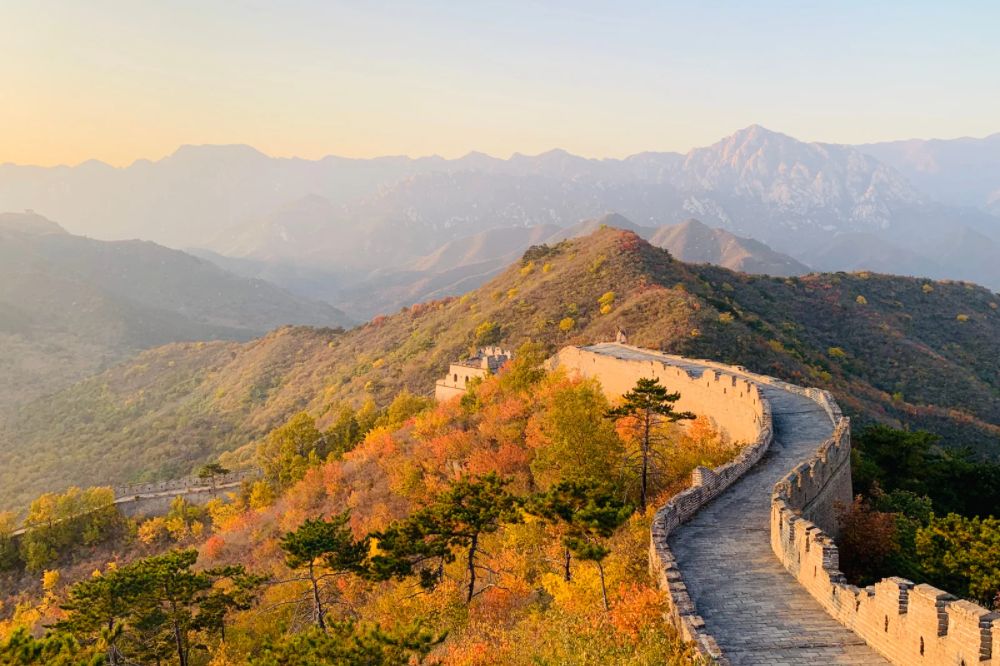
In fact, the Great Wall of China was so much more than I could foresee. It was magnificent. In fact, I truly loved my entire visit to China and highly recommend spending some time there. See the reasons I loved China so much. How much do you know about China?
Learn a few interesting facts about it before you visit! The Great Wall of China is one of the top tourist attractions in the world, drawing more than 10 million visitors from all corners of the globe every year. It’s one of those really cool experiences that everyone should have in their lifetime.
They don’t call it one of the 7 Great Wonders of the World for nothing. Just standing on it, peering out over the vast countryside below, you can almost sense the pride and determination that it took to build it.
You can almost feel the years of toil and anguish the soldiers, convicts and laborers who constructed it must have felt, you can almost see the world in which building something so massive was necessary. It’s a living piece of history that I feel privileged to have walked on.

Table of Contents
How to Walk the Great Wall of China
If you’re wondering can you walk the Great Wall of China, the answer is yes. Of course you can! There are a few sections of the wall that are open to tourists. Where you go depends greatly on what you want to do there and how far you’re willing to go.
Badaling Section
We entered the Great Wall at the Badaling Section, which is both the easiest entrance to get to and the most frequented by tourists. It’s only about 45 miles from Beijing and can be reached by train and bus, if you’re on your own, or with any number of tour companies.
The section of the wall at Badaling is the most well-preserved and stretches some 7.5 miles, though only about 4,000 yards of it are open to the public.
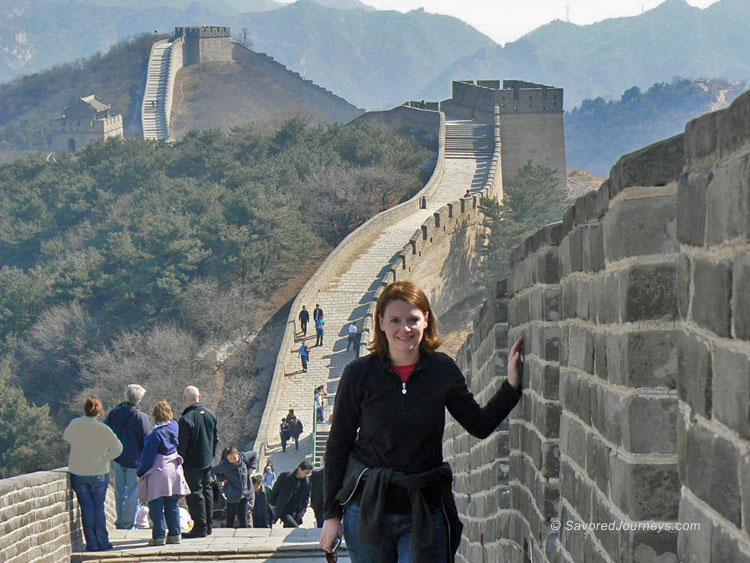
If you’re just wanting to see the wall in as close to original condition as possible, Badaling is the place to go. Other sections of the Great Wall of China are not as well preserved, or have even crumbled out of existence.
There is a group tour you can take from Beijing to the Badaling section of the wall. It’s an 8-hour trip that also includes a visit to the tomb of one of the most important Ming Dynasty emperors. This is a great way to see the wall without needing to do the planning and figuring out of transport on your own.
If you’d rather plan your own trip, but ensure you have a ticket to get in once you arrive, you can buy your Badaling entry ticket here .
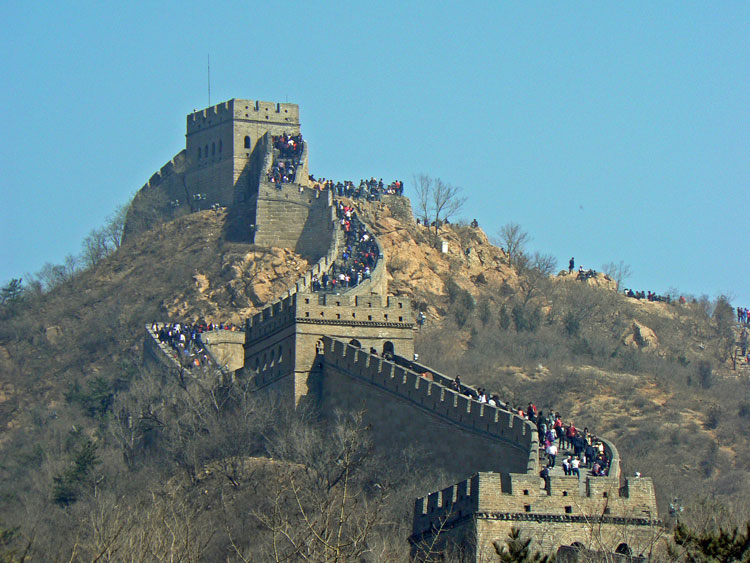
What to Expect
The entrance at Badaling offers very little fanfare. There is a restaurant or two, a couple of souvenir shops, a museum and an exhibit on the Terracotta Warriors (in case you can’t make it all the way to Xian to see them in person).
At the gate, you grab your ticket and decide which side of the wall you wish to walk. We chose the south side, which had less people on it, and I’m really glad we did. We were able to take our time walking up the exceptionally steep inclines, peer over the edges for as long as we wanted and snap some really nice pictures along the way.
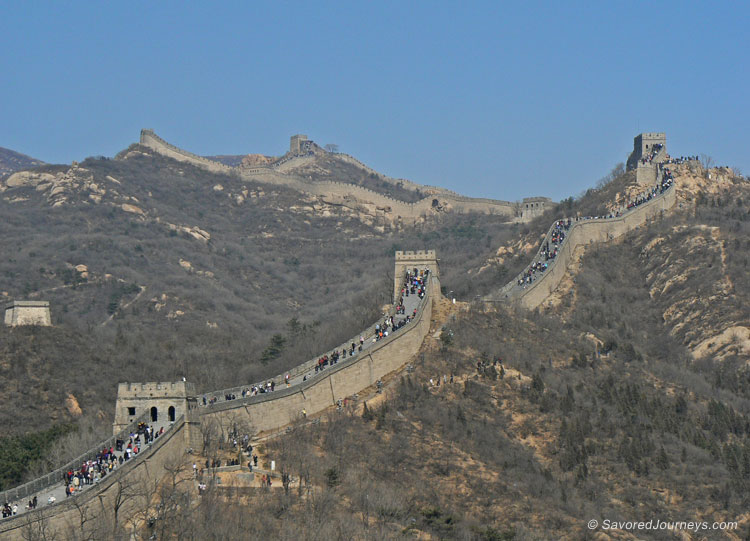
The North route may be more famous or more scenic, but I thought it was nice to take pictures looking to the north rather than walk (or should I say hike) it with the ever-present fear of passing out from lack of oxygen, although they do provide a cable car that will take you to the top, so you don’t have to worry.
The climb at times can be quite arduous and I can only imagine how difficult of a feat it was to build in an era without the help of modern building techniques. I wouldn’t recommend walking it on a rainy or particularly cold day, as you might find yourself landing on your butt more times than you care to.
It’s not only steep, it’s slippery in places where the brick has been warn by the ever-present traipsing of tourists.

On the south side of the wall, there are five towers, from which the rest of the path appears to be draped like streamers for miles in the distance. From afar, it’s quite an incredible view. I imagine that another time of the year would have afforded us the addition of green vegetation or autumn foliage.
But we were there to see the wall, after all, not the trees. There is a cable car at the south side that you can ride to the top, so you don’t need to climb those steep steps. The cost of the cable car is 40 CYN one way or 60 round trip. That is in addition to the 40-45 CYN you must pay to get in.
Mutianyu Section
Mutianyu is a section of the Great Wall of China located in the Huairou District, also about 45 miles to the northeast of the center of the city.
Like Badaling, Mutianyu is also a well preserved section of the wall. It often has less tourists, as well, so you might not see the long lines and crowds you find at Badaling. To reach this section of the wall, you can take the Mubus from the city center that goes directly there or you can book a private tour that includes the wall and Summer Palace. I think this is definitely the way to go!
There’s also a guided tour option to the Jinshaling section that includes transportation and a guided hike from Beijing.

This part of the wall is 3.4 miles in length and it has been renovated, so it’s safe to climb. You can enter at two points – the north and the south. Both require quite a bit of hiking. The cable car is located near the North entrance and should be used by anyone who can’t or doesn’t want to hike.
The cost to get into Mutianyu is around 40 CYN ($5 USD). The cable car costs 100 CYN for adults, 50 CYN for kids. Then you can take a chair lift or a toboggan ride down for the same cost.
When to See the Great Wall of China
I went to the wall in March and the “traffic” wasn’t at all bad. I’ve seen other traveler’s pictures where some parts of the walkway were so packed that it more resembled a crowded nightclub than the great wonder that it should be.
Sharing the wall with all of those people can cheapen the experience and mar any pictures you might take. For that reason I would really suggest visiting the Great Wall of China at a more pleasing (less crowded) time.
Those times are typically in the spring and fall (March-May and Sept-Nov). You can go all year round, though, if your schedule doesn’t allow you to go during the shoulder season.
Final Thoughts on Walking the Great Wall of China
This is definitely one of those experiences you must try in your lifetime. To see the Great Wall of China is a splendid thing that you can only imagine until you see it in person.
There are other ways you can experience the Great Wall of China, like hiking the Great Wall of China and camping out overnight or even running a marathon. If you’re into something alternative, you should look into those options too.
Be Prepared For Travel Planning is the most important part of any successful trip. Do it the easy way:
🧳 Travel Packing List | ✔️ Why You Need Travel Insurance | ✈️ What to Do Before You Leave Home
- Find and book the best hotel (our favorite booking site is Expedia)
- Research flight options (our favorite tool is Skyscanner )
- Book a tour (we always use Viator to find the best tours)
- Rent a car through Discover Cars (they search the best deals for you!)
YOU MIGHT ALSO LIKE

50 Things to Know Before You Go Abroad

12 Exciting Travel Destinations in Asia

21 Top Foodie Destinations Around the World

Top 10 Tibetan Foods You Must Try in Lhasa
Like this post? Why not save it to Pinterest? FOLLOW US on Pinterest , Instagram , Facebook for more great travel inspiration and tips.

Laura Lynch, creator and writer of Savored Journeys, is an avid world traveler, certified wine expert, and international food specialist. She has written about travel and food for over 20 years and has visited over 75 countries. Her work has been published in numerous guidebooks, websites, and magazines.
One thought on “ How to Visit the Great Wall of China ”
Pingback: Why I Travel: The Joys & Benefits of Traveling the World | Savored Journeys
Leave a Reply Cancel reply
Your email address will not be published. Required fields are marked *
Save my name, email, and website in this browser for the next time I comment.
- Travel Resources
- Share full article

Golden Visa Programs, Once a Boon, Lose Their Luster
Spain is the latest European country to end its program, which brought in billions of euros from real estate investors seeking residency status but worsened a housing crisis for locals.
Apartments in Madrid. Golden visa programs are being phased out or shut down around Europe. Credit... Emilio Parra Doiztua for The New York Times
Supported by

By Liz Alderman
Liz Alderman, who writes about economics, has widely covered Europe’s financial crisis and the aftermath.
- Published April 21, 2024 Updated April 22, 2024
When Ana Jimena Barba, a young doctor, began working at a hospital in Madrid last year, she moved in with her parents half an hour outside the city until she could save enough to buy her own home. But when she started looking at houses in the same village, almost everything was priced at more than 500,000 euros.
The amount — nearly 20 times more than the average annual salary in Spain — happens to correspond to the cost of the country’s “golden visa,” a program that offers residency to wealthy foreigners who buy real estate there. After a decade, the program has reeled in billions of euros in investments, but it has also helped fuel a wrenching housing crisis for its own citizens.
“There’s nothing I can afford,” said Dr. Barba, an allergist who has been working 100 hours overtime every month to save up a nest egg. “If foreigners inflate the prices for those of us who live here, it’s an injustice,” she said.
Faced with growing pressure to address its housing crunch, Spain said this month that it would scrap its golden visas, the latest in a wider withdrawal from the program by governments around Europe.
Half a dozen eurozone countries offered the visas at the height of Europe’s debt crisis in 2012 to help plug gaping budget deficits. Countries that needed international bailouts — Spain , Ireland , Portugal and Greece among them — were especially desperate for cash to repay creditors, and saw a path to bring in investors while reviving their moribund real estate markets.

Countries reaped a windfall: Spain alone has issued 14,576 visas linked to wealthy buyers making real estate investments of more than €500,000. But the prices that they can afford are squeezing people like Dr. Barba out of a market that had already been highly inflated by the rise of Airbnb and the draw of Wall Street investors.
“Access to housing needs to be a right instead of a speculative business,” Pedro Sánchez, Spain’s prime minister, said in a speech this month as he announced the end of the country’s golden visa program. “Major cities are facing highly stressed markets, and it’s almost impossible to find decent housing for those who already live, work and pay their taxes.”
The visas make it easy for people outside the European Union to buy the right to temporary residency, sometimes without having to live in the country. Investors from China, Russia and the Middle East flocked to buy real estate through them.
In recent years, British nationals have followed suit in the wake of Brexit, snapping up homes in Greece, Portugal and Spain, joined by an increasing number of Americans looking to enjoy a lifestyle they can’t afford in major U.S. cities.
But golden visa programs are now being phased out or shut down around Europe as governments seek to undo the damage to the housing market. And after Russia’s invasion of Ukraine, E.U. officials urged governments to end them, warning they could be used for money laundering, tax evasion and even organized crime.
Portugal, which has reaped more than €5.8 billion in investment from the visas, modified its program in October to remove real estate as an investment to reduce speculative buying and cool an overheated housing market. An influx of foreigners has displaced thousands of low-income Portuguese citizens from homes in cities like Lisbon.
The government in Lisbon is trying to fix the affordable housing problem with new rules that would require landlords to rent empty flats to families, capping rents and converting some commercial real estate to housing.
Ireland shut down its program last year, in part to address concerns that Russian nationals were laundering money through it.
Greece , one of the last countries in Europe to offer a golden visa, is raising its foreign investment threshold to €800,000 from €500,000 in the Athens area and on popular islands including Mykonos and Santorini. The country’s prime minister, Kyriakos Mitsotakis, acknowledged severe housing shortages and pressure on rental markets, especially around Athens, but he said the government still wanted to draw investors. Greece raised €4.3 billion in investment from the visas from 2021 to 2023 alone.
A report released by the Institute of Labor Economics in March said the visa programs had helped spur economic development in countries offering them. But governments need to strike “a delicate balance between reaping economic benefits and safeguarding against potential risks,” including money laundering and rampant gentrification, the report said.
The pullback is coming as a broader housing crisis grips Europe , after years in which its real estate markets have undergone a profound metamorphosis that has increasingly pushed out modest-income workers, including doctors, teachers and police officers.
Gentrification has spread throughout European cities for decades, but the rise of Airbnb and other short-term rental providers has accelerated the affordability crisis. That was especially the case in countries affected by Europe’s debt crisis, where property owners discovered they could make more by renting to tourists than to locals whose finances had been squeezed by austerity programs.
Golden visa programs compounded the strain. In Greece, which initially granted foreigners a five-year residency visa if they invested €250,000, many apartment and home listings around Athens and on breezy Greek islands suddenly shot up from bargain-basement prices to €250,000, well out of reach for most Greeks.
Laura McDowell, an agent at the Athens-based Mobilia real estate agency, said that short-term rentals had made rents unaffordable in city centers, and the problem was worsened when investors from numerous countries converted homes purchased through golden visa programs to vacation rentals, further squeezing the supply of affordable housing.
The scheme lured Chinese nationals in particular, with many flying to Athens carrying suitcases loaded with cash . Chinese investment companies also bought buildings in low-income neighborhoods and areas with student housing, renovating apartments and reselling them to visa seekers. Today, entire apartment blocks even in once undesirable zones in and around Athens are owned largely by foreigners.
“Prices driven up by golden visas haven’t come down,” Ms. McDowell said. “Greeks have been priced out.”
In Spain, Chinese investors made up nearly half of visa seekers, followed by Russians. Low interest rates set by the European Central Bank compounded the problem in recent years by drawing more real estate investors outside the visa program, said Ernest Urtasun, Spain’s culture minister.
The Spanish government plans to construct 40,000 social housing units for people with limited resources as part of a broader plan to restore affordable lodging.
But it is uncertain that will help people like Dr. Barba quickly. Despite Spain’s recovery from the financial crisis, wages have failed to keep pace with the growth in the real estate market. Nearly a fifth of workers earn the minimum wage of €1,134 a month, while rents in Madrid jumped 15 percent in 2023. A 3.2 percent inflation rate has added to the strain.
Dr. Barba has been saving money for the past three years for a down payment on a home. She rented a room in a shared apartment in Barcelona when she began training as an allergist at a downtown hospital. But her monthly income was consumed by basic living expenses including food, rent and transport.
To save more, she transferred to the hospital in Madrid and now lives with her parents rent-free outside the city, working overtime to bump up her salary to €1,900. But with homes even in her parents’ village priced at half a million euros, she feels hopeless.
“It would take years to save up enough to put down a deposit on a home,” Dr. Barba said. “Buying a home is just a dream.”
Rachel Chaundler contributed reporting from Madrid, and Niki Kitsantonis from Athens.
Liz Alderman is the chief European business correspondent, writing about economic, social and policy developments around Europe. More about Liz Alderman
Explore Our Business Coverage
Dive deeper into the people, issues and trends shaping the world of business..
A Lead in Green Energy: A subsidiary of ThyssenKrupp, Germany’s venerable steel producer, is landing major deals for a device that makes hydrogen, a clean-burning gas, from water.
A Wealth Shift: Assets held by baby boomers are changing hands, but that doesn’t mean their millennial heirs will be set for life.
Daniel Ek’s Next Act: The Spotify chief has co-founded a new start-up, Neko Health, that aims to make head-to-toe health scans part of the annual health checkup routine.
Handling Finances: People who suddenly lose a spouse while young can feel unprepared for what their future looks like. Here’s how to be prepared .
What Would Jesus Do?: The “Yes in God’s Backyard” movement to build affordable housing on faith organizations’ properties is gaining steam in California and elsewhere.
What Is a ‘Decent Wage’?: Michelin, the French tire maker, vowed to ensure that none of its workers in France would struggle to make ends meet.
Advertisement
Politics latest: 'Major moment' in SNP leadership race - as serviceman 'turned away' from polling station
Former SNP leader John Swinney is "heading for a coronation" after Kate Forbes, widely tipped to go up against him in the party's latest leadership contest, announced she would not run. Meanwhile, England and Wales are holding local elections that may be defining for Rishi Sunak.
Thursday 2 May 2024 15:07, UK
Please use Chrome browser for a more accessible video player
- John Swinney to run for SNP leader | But Kate Forbes will not
- Connor Gillies: Major moment as Swinney heads for coronation
- Polls open in England and Wales I How to watch Sky News coverage
- Elections taking place across 107 local authorities in England
- Mayoral contests are also taking place, including in London
- Twenty-five London Assembly seats are up for grabs
- A by-election is taking place in Blackpool South
- Voters across England and Wales will elect 37 police and crime commissioners (PCCs)
- Live reporting by Charlotte Chelsom-Pill
Protesters in Peckham, south London, have blocked a coach due to take asylum seekers who have been housed in a local hotel to the Bibby Stockholm barge in Dorset.
Police have warned the demonstrators will be arrested if they do not leave the scene.
Home Secretary James Cleverly has addressed the incident on social media, saying: "Housing migrants in hotels costs the British taxpayer millions of pounds every day.
"We will not allow this small group of students, posing for social media, to deter us from doing what is right for the British public."
Our correspondent Sadiya Chowdhury is at the scene, and says protesters have been chanting in solidarity with migrants and voicing opposition to the police.
It is something of a tradition to show pictures of dogs at polling stations on an election day.
Donkeys, not so much - until now.
Please enjoy this glum looking donkey waiting in a parking bay at a village hall polling station in the New Forest.
And in case you are wondering why dogs (and now donkeys) are such a feature of our election coverage today, it's (partly) down to reporting restrictions.
On polling day, you won't see any coverage about politics or policy concerning the parties involved.
Instead, you will see coverage of people voting, politicians casting their ballots and yes … lots of dogs at polling stations.
Downing Street has said it will "look into" voter ID rules after a serviceman was turned away from a polling station.
The serviceman was unable to use his veterans ID card, introduced at the start of the year, to vote.
Responding on X, veterans' affairs minister Johnny Mercer said: "The legislation on acceptable forms of ID came out before the veterans ID cards started coming out in January this year.
"I will do all I can to change it before the next one."
The prime minister's spokesperson reiterated that this form of ID was introduced "very, very recently".
"I think it's something that we will want to look into," the spokesperson said.
"There's already a very wide range of acceptable documents - including a free voter authority certificate - which is accepted at all polling stations so anyone who is eligible to vote can continue to do so."
However, the spokesperson said Downing Street had no concerns about voter ID more generally, adding: "We don't want to see anyone turned away from polling stations, we want everyone to be able to vote.
"Experience from the last local elections was that 99.75% of people were able to cast their vote successfully."
We have compiled a list of what counts as voter ID below:
John Swinney is "heading for a coronation" as the next leader of the SNP after the decision by Kate Forbes not to run, says our Scotland correspondent Connor Gillies .
Ms Forbes was the main rival to Humza Yousaf in the last contest, amassing almost half of the vote.
With her choosing not to go up against former leader Mr Swinney, it's "incredibly unlikely any other candidate will throw their hat in the ring".
Connor describes it as a "major moment", coming after backroom discussions throughout today at Holyrood.
As of last night, he says Ms Forbes hadn't decided what to do - but she appears to have been swayed by Mr Swinney's speech this morning.
"Sources close to her were concerned there would be disappointment at her not throwing her hat in the ring," he says.
"But she says she is rallying behind a John Swinney premiership."
If anyone did want to run against him, they would have until midday next Monday to enter the race.
But Connor says the race is now all but over already.
Kate Forbes has announced she will not join the race to replace Humza Yousaf as SNP leader and first minister.
There had been speculation the former Scottish finance secretary would join John Swinney, who threw his hat in the ring earlier today.
In a statement, Ms Forbes said: "Ultimately, I have concluded that the best way to deliver the urgent change Scotland needs is to join with John Swinney and advocate for that reform agenda within the Scottish government.
"It is now clear from this morning's statement that in John Swinney we have someone who not only understands that need for reform, but has now committed to delivering it.
"I look forward to playing my role in making that happen."
Posting on X, Ms Forbes added that she had spoken to Mr Swinney directly to "discuss the future of our party and our country".
"What emerged was that we share a powerful common purpose for the country," she said.
Confirming he was standing for first minister and SNP leader earlier today, Mr Swinney said. he wanted to "unite the SNP and unite Scotland for independence".
He also said he would like to see Ms Forbes "play a significant part" in his team should he be appointed.
The leadership race comes after Mr Yousaf announced he was standing down as SNP leader and Scotland's first minister earlier this week.
As we just reported, a statement from Kate Forbes on the race to succeed Humza Yousaf as Scotland's first minister is expected shortly.
She lost out to Mr Yousaf in last year's SNP leadership contest and has already told Sky News she is considering entering the race again in the wake of Mr Yousaf's resignation.
The former finance secretary faced backlash during her campaign last year after admitting she would have voted against gay marriage in Scotland when it was made legal a decade ago.
The Free Church of Scotland member also told Sky News that having children out of marriage was "wrong" and something she would "seek to avoid".
However, the MSP for Skye, Lochaber and Badenoch stressed that "in a free society you can do what you want".
Ms Forbes had argued that "continuity won't cut it".
After losing to Mr Yousaf by 48% to 52%, she said: "If we are to continue to win elections, we need to continue to listen and maintain trust."
Ms Forbes turned down the role of rural affairs minister, which at the time was seen as a demotion.
Although her views on social issues remain unpopular with some of her MSP colleagues, she was one of the few SNP ministers who did not delete her WhatsApp messages during the COVID pandemic.
Ms Forbes would face resistance from the Scottish Greens, who have previously ruled out working with her.
SNP colleague Fergus Ewing is backing Ms Forbes, saying she is "head and shoulders" above any other potential candidate.
Kate Forbes has been widely tipped to run for the SNP leadership once again after Humza Yousaf's resignation - and we'll hear from her shortly.
Our Scotland correspondent Connor Gillies reports a statement is "imminent in the next 30 minutes".
It follows John Swinney, a former SNP leader, announcing he's running for the top job this morning.
We'll bring you Ms Forbes's statement when we get it.
By Jenness Mitchell , Scotland reporter
John Swinney has announced his bid to take over from Humza Yousaf as SNP leader and Scotland's first minister.
The Perthshire North MSP has spent a year on the backbenches after he stepped down as deputy first minister when Nicola Sturgeon resigned in 2023.
Announcing his intention to run for first minister during a visit to Grassmarket Community Project in Edinburgh on Thursday, he said: "I want to build on the work of the SNP government to create a modern, diverse, dynamic Scotland that will ensure opportunities for all of our citizens.
"I want to unite the SNP and unite Scotland for independence."
Mr Swinney accepted that the SNP is "not as cohesive as it needs to be" to achieve its goal of Indyref2.
He said: "That has to change. I could have stood back and hoped others would sort things out, but I care too much about the future of Scotland and the Scottish National Party to walk on by."
The search is currently on to find a new leader for the SNP and Scotland following Mr Yousaf's resignation on Monday.
Former finance secretary Kate Forbes is expected to give a statement later on Thursday.
Read more here:
It might well end up being Humza Yousaf's last First Minister's Questions, but opposition leader Douglas Ross isn't going easy on him.
The Scottish Tory used his questions to attack the SNP's record, including that of the party's former leader John Swinney, who this morning announced his bid to get the top job once again.
Mr Yousaf bit back, criticising the opposition party and Mr Ross's time in Boris Johnson's cabinet.
That prompted Mr Ross to flaunt a letter sent to him by Mr Yousaf last week when it became apparent that his government was in trouble, with the Tories and Labour filing motions of no confidence after the first minister booted out the Scottish Greens.
"He's talking a big game now," said Mr Ross.
"Has he forgotten it was just last Friday he wrote this humiliating letter to me begging the Conservatives and our colleagues here to save his skin?!
"How quickly things change in the world of Humza Yousaf."
Outgoing SNP leader Humza Yousaf is holding what could be his final First Minister's Questions this lunchtime.
Mr Yousaf resigned earlier this week after kicking the Scottish Greens out of government, which led to a motion of no confidence in him.
He arrived at the Scottish Parliament to spar with Scottish Tory leader Douglas Ross, Scottish Labour leader Anas Sarwar and other MSPs.
'I'm proud of my record'
Mr Yousaf - whose potential replacement John Swinney launched his leadership bid this morning - said he was "proud" of the SNP government's record despite not getting "everything right".
"I'm very proud of the fact I became the first person of colour to become first minister, the very first Muslim leader of a Western nation, the youngest first minister to ever serve in 25 years of devolution," he said.
Mr Yousaf has only been first minister for 13 months, but has served in the government for more than 12 years.
He also defended Mr Swinney and another potential leadership contender Kate Forbes from Mr Ross's barbs, describing them as "both more popular" that the Conservative leader.
Be the first to get Breaking News
Install the Sky News app for free


IMAGES
VIDEO
COMMENTS
The 1 day Great Wall tour price is around CNY500-1,000, which is USD75-150. Carefully select a reliable travel agency. If the Great Wall of China tour cost is less than USD75 dollars, you should be cautious; there is a great possibility the tour includes secondary consumption or forced shopping.
A: You can visit the Badaling, Mutianyu, or Juyongguan sections of the Great Wall of China on a half- day trip from Beijing. The journey generally takes 1.5 hours each way and most travelers spend 2 to 3 hours exploring the Great Wall of China, walking on it, and taking photos.
Prices can vary depending on what time of year you visit. During the summer, entrance fees range from 40-65 Yuan (£4.35-£6.52), but from November to March prices drop to 35-55 Yuan (£3.80-£6.00). If you book a private Great Wall of China tour, the cost of entry is normally included in the price.
To get the most from the Great Wall, a must-visit China attraction, you should follow the advice to plan a perfect Great Wall trip: 1. Choose the Best Times to Visit. 2. Select the MOST Suitable Section to Visit. 3.
A Complete Guide to Visiting the Great Wall of China. The Great Wall of China stretches 13,000 miles over mountains, forests, reservoirs, and desert. It took a millennium to build, involved multiple dynasties, and pissed off a lot of Huns. Inextricably tied to the history of the country, to visit China without seeing it would cause you to be ...
The Great Wall of China is without a doubt one of the world's most popular attractions. People from all over the world have firmly placed a visit to the Great Wall on their travel bucket lists. But, with the Great Wall being such a popular attraction, many visitors would expect a trip to one of the world's seven wonders to cost a pretty ...
But taking the weather condition, crowdedness and cost into consideration, there are two periods of time which are perfect for Great Wall visit. The first best time is April to June when the weather is temperate and the vegetation surrounding the Great Wall begin to blossom. ... Yes, you can visit the Great Wall of China, but only the Simatai ...
Beijing and the Great Wall Day Tour. 2 days Beijing highlight tour. 3 days Beijing tour. Golden Triangle of China - 9 days Beijing, Xian, Shanghai tour. The Classic China Tour - 13 days Beijing, Xian, Guilin, Yangshuo, Shanghai tour. The Ancient Capitals - 5 days Beijing, Xian tour. Tale of Two Cities - 5 days Beijing, Shanghai tour.
Tip 3: Avoid weekends or public holidays. It is better to hike the Wall during the weekdays instead of weekends. Strongly advise you not to visit the Wall during China public holidays ( Especially May 1-3, and October 1-7). Crowds at Badaling Great Wall during public holidays.
Beijing, the capital city, possesses about 573km (356 miles) of the Great Wall including the world famous Badaling, Mutianyu, Jiankou, etc., stretching alone the steep peaks and hills at its remote northern districts. You can easily plan a satisfied day trip to the closer sections of the Great Wall from Beijing.
Find suitable 2024/2025 Great Wall tour package which takes you to explore the beautiful and less-crowded sections of Great Wall at low cost with professional local Great Wall guide. ... The Great Wall of China is not just a single wall to see, actually it consists of many different sections. ... Visit Great Wall with Other Popular Beijing ...
6. Don't visit the (popular sections of) Great Wall on weekends or Chinese holidays (in peak season). It can be extremely crowded at sections like Badaling. 7. Don't leave rubbish on the Great Wall or on the mountains. Keep the wall clean, and then other travelers can enjoy the scenery. 8.
The Great Wall of China is more than 13,000 miles long. That's more than 21,000 kilometers. And the easiest place to visit the Great Wall from is the capital of China, Beijing. However, there are five different areas of the Great Wall that it's possible to visit as a day trip from Beijing, so you need to decide which part to visit.
The Bei Qi kingdom (550-577) built or repaired more than 900 miles of wall, and the short-lived but effective Sui Dynasty (581-618) repaired and extended the Great Wall of China a number of times.
A recent government mapping project revealed that the entire Great Wall structure spans some 5,500 miles (8,850 kilometers) from the Korean border west into the Gobi desert. Of that total 3,889 ...
Great Wall of China, extensive bulwark erected in ancient China, one of the largest building-construction projects ever undertaken.The Great Wall actually consists of numerous walls—many of them parallel to each other—built over some two millennia across northern China and southern Mongolia.The most extensive and best-preserved version of the wall dates from the Ming dynasty (1368-1644 ...
Mutianyu Great Wall Scenic Area is a well-preserved section of the Great Wall of China, built in 1368. It stretches from Gubeikou to Juyongguan and served as a strategic military defense. The area features famous landmarks such as Zhengguantai, Dajiaolou, and Yingfeidaoyang, reflecting the ancient charm of the Great Wall.
Admission. Beat the crowds by purchasing the Badaling Great Wall tickets in advance. Guarantee your entry as the Badaling Great Wall allows only 65,000 visitors a day. Free change and cancellation as long as you send the request before deadline. From CNY35/US$5 per person.
The Great Wall at Badaling is located 72 kilometers northwest of Beijing city center, taking 1½ hours to get there by taxi.You can also get to the Great Wall at Badaling by S2 train and will be able to get there in a bullet train by 2020.. Option 1. By Taxi (1½ hours, $36) It costs about 240 yuan ($36) with the toll fee included each way to get to the Great Wall at Badaling scenic area from ...
Learn a few interesting facts about it before you visit! The Great Wall of China is one of the top tourist attractions in the world, drawing more than 10 million visitors from all corners of the globe every year. ... The cost of the cable car is 40 CYN one way or 60 round trip. That is in addition to the 40-45 CYN you must pay to get in ...
The amount — nearly 20 times more than the average annual salary in Spain — happens to correspond to the cost of the country's "golden visa," a program that offers residency to wealthy ...
By Jenness Mitchell, Scotland reporter. John Swinney has announced his bid to take over from Humza Yousaf as SNP leader and Scotland's first minister. The Perthshire North MSP has spent a year on ...